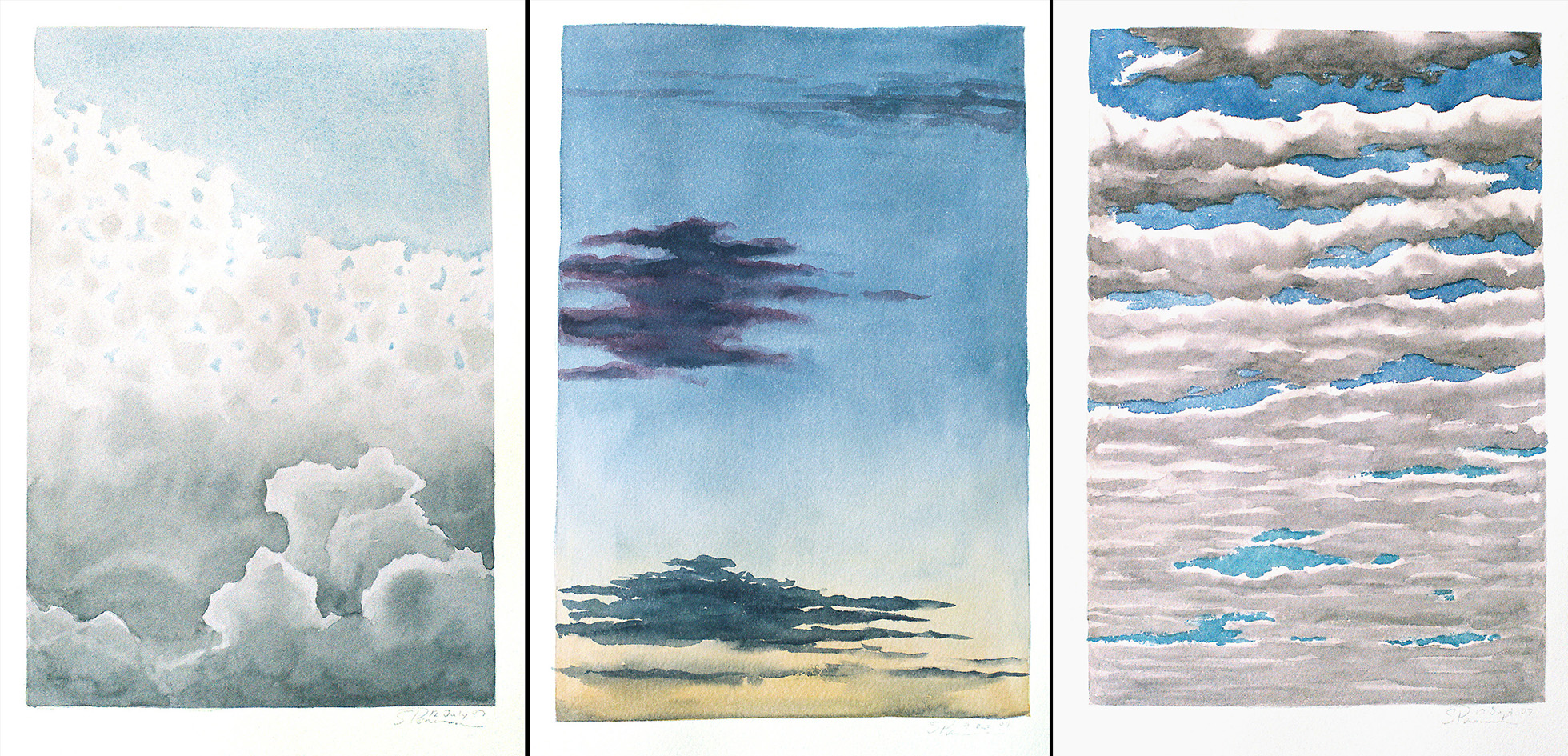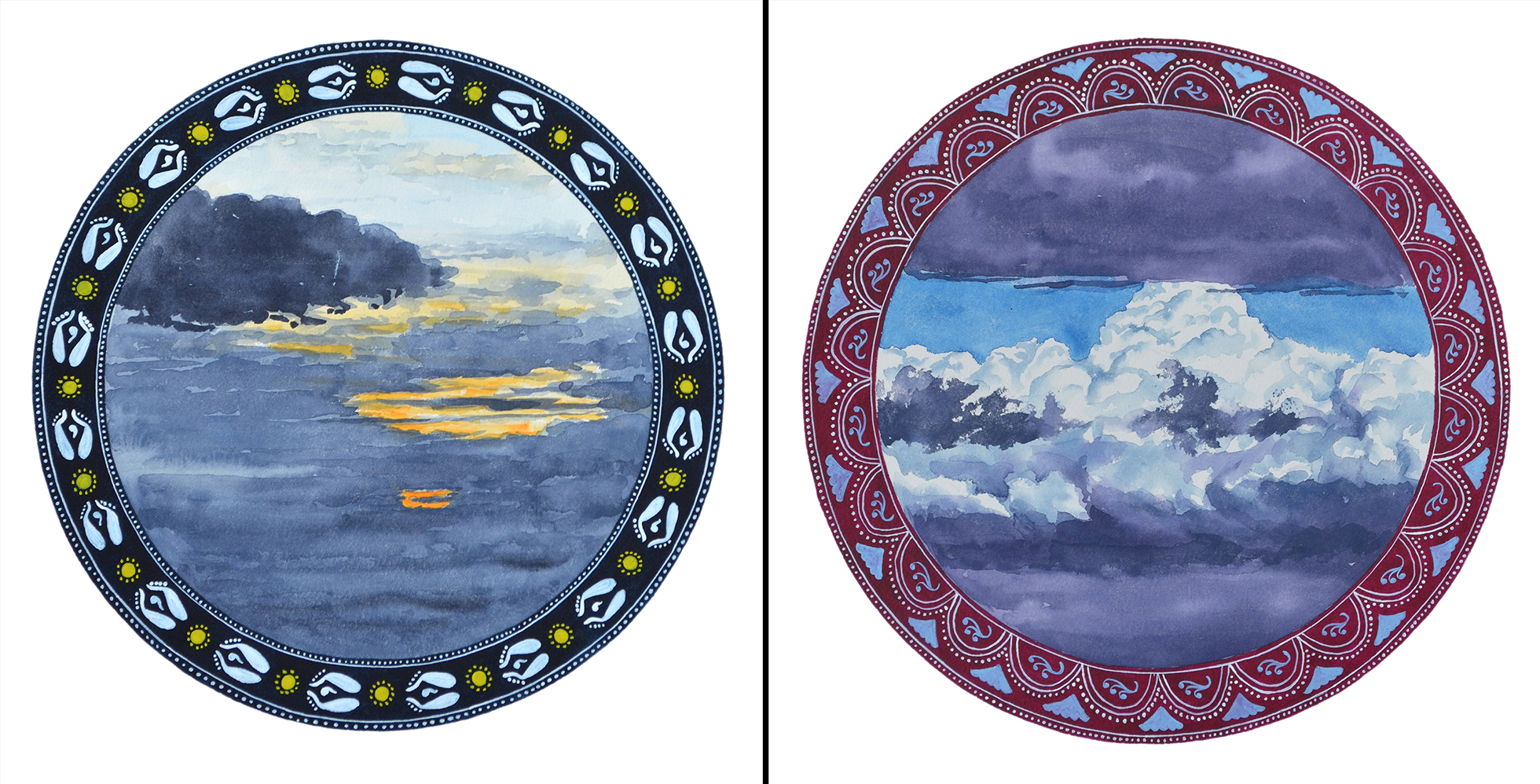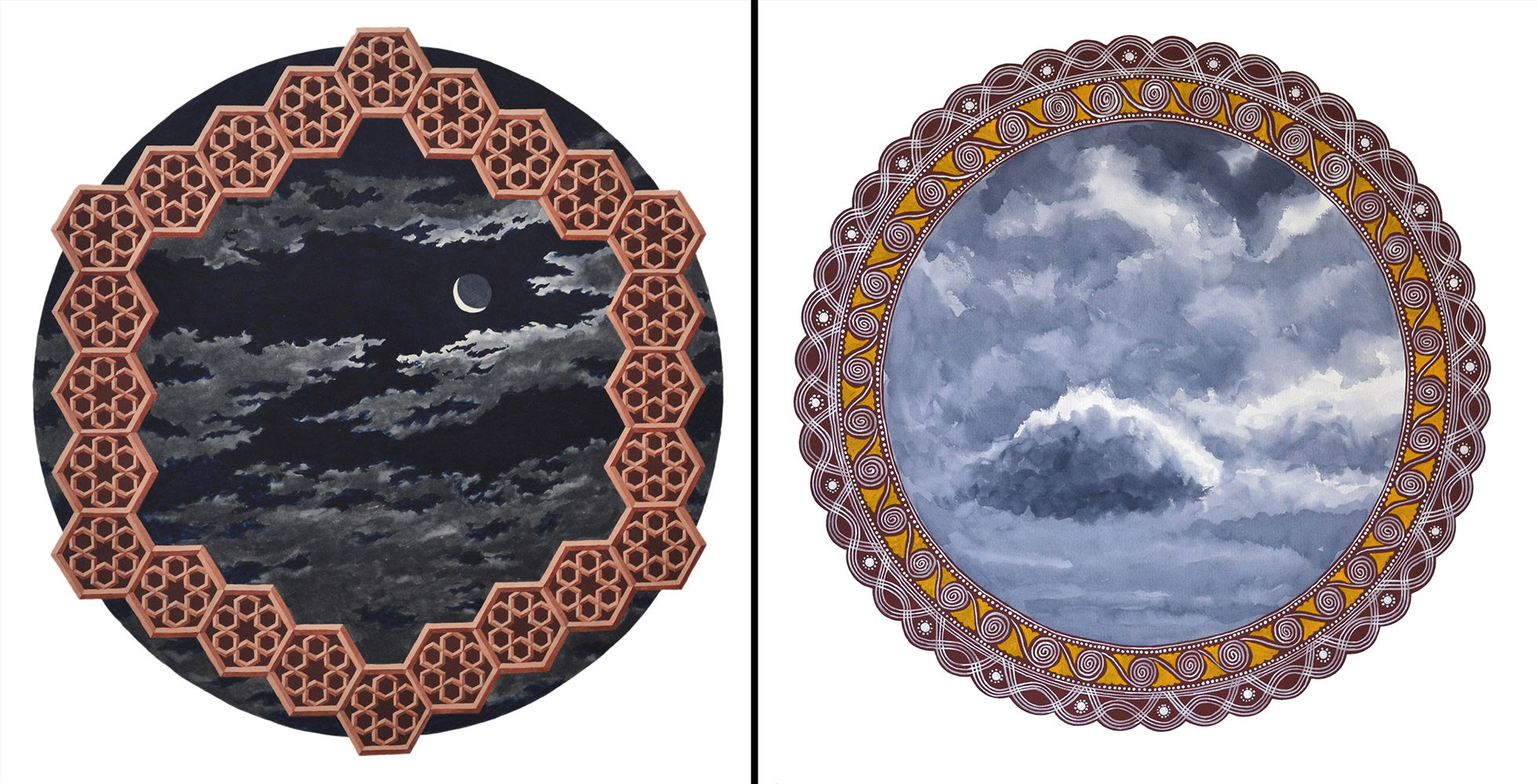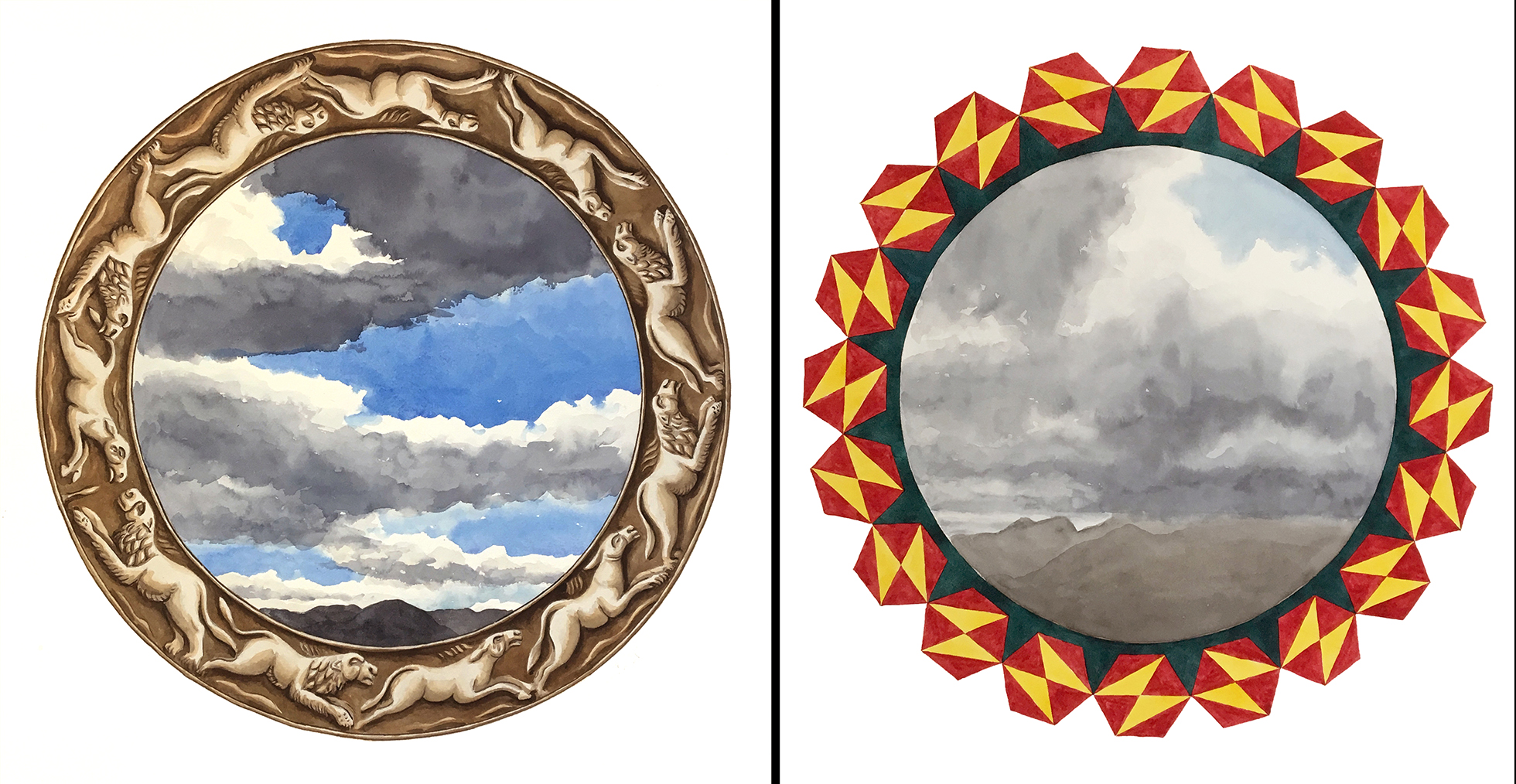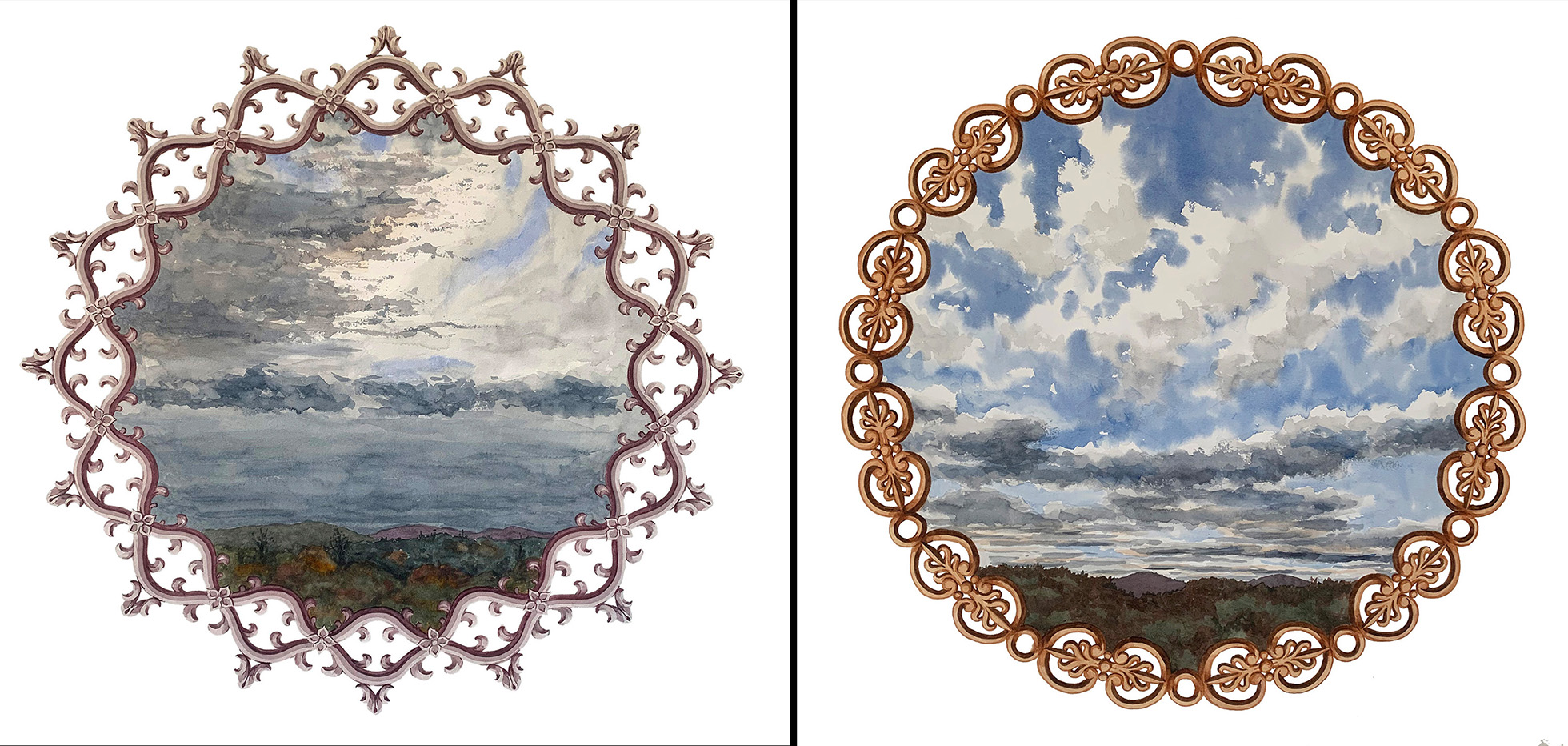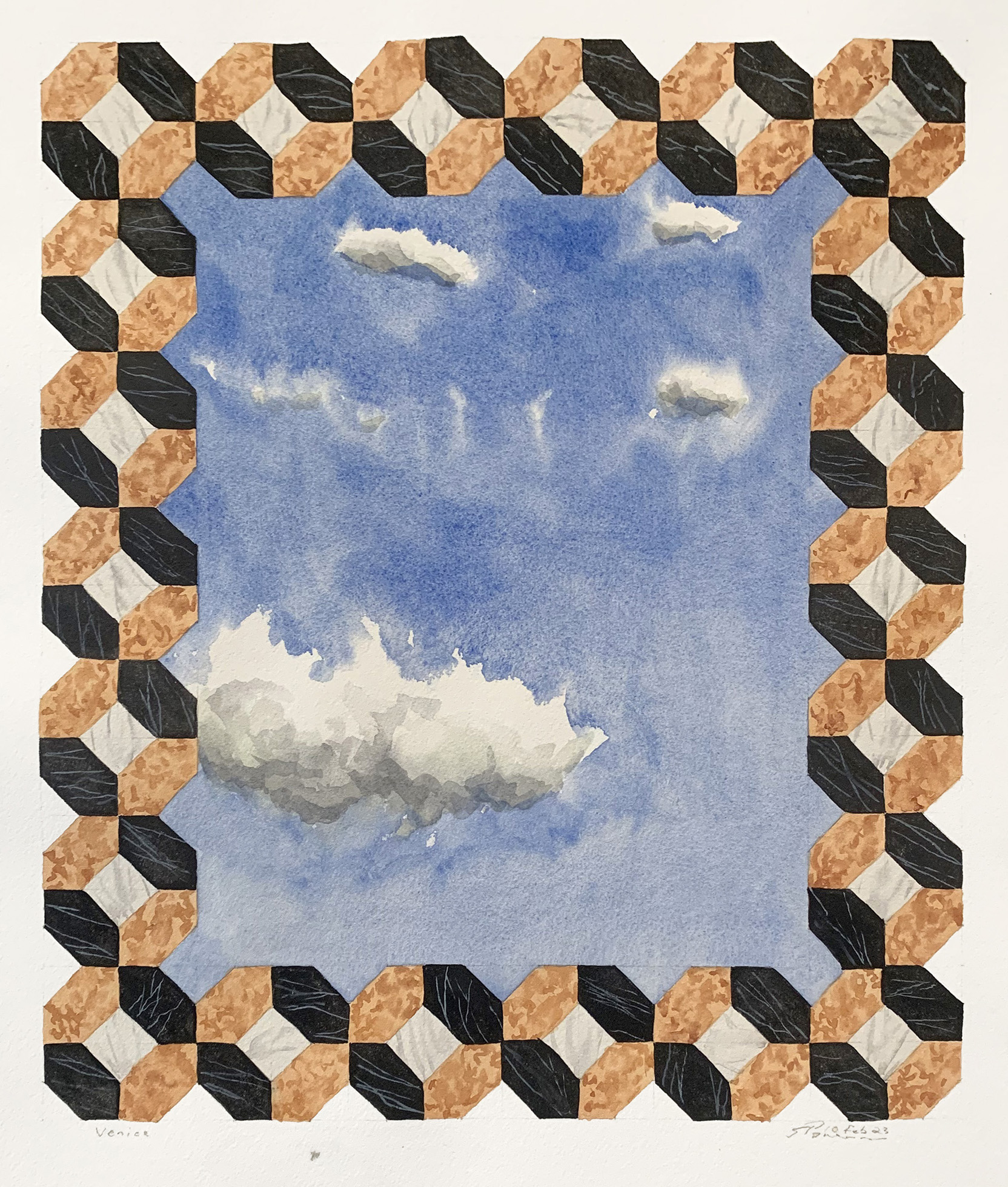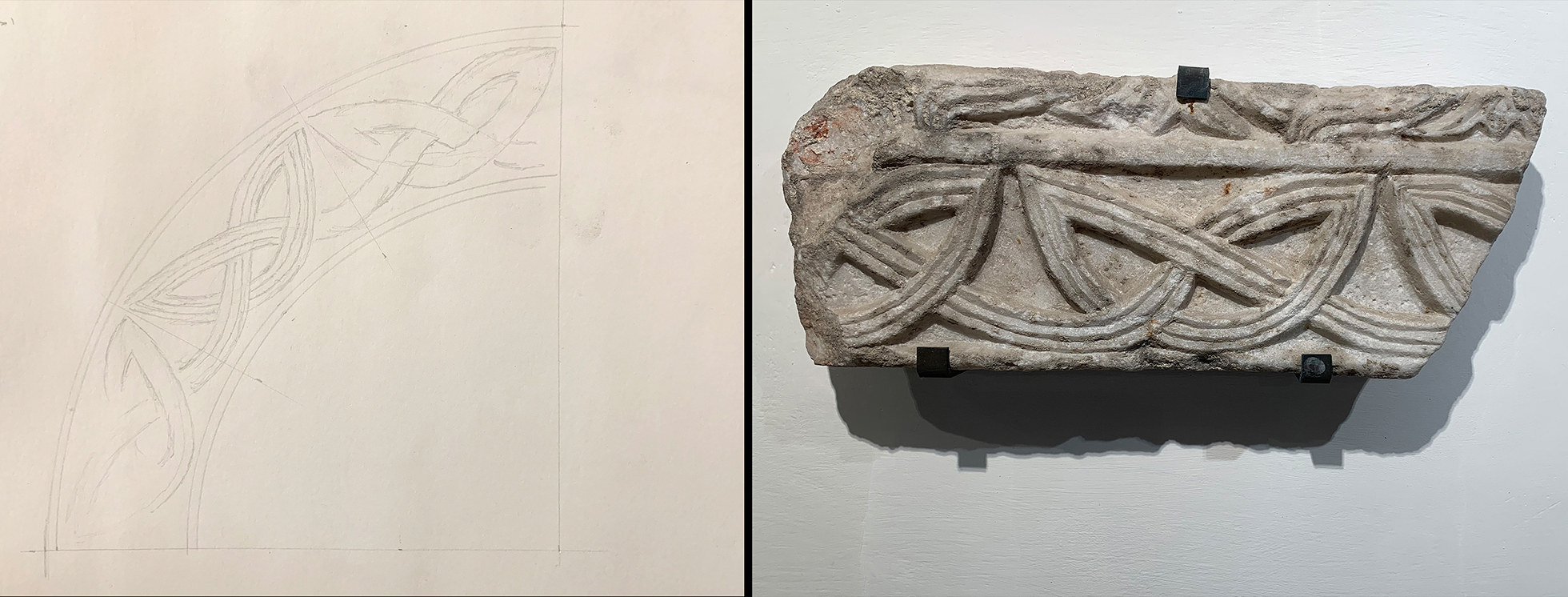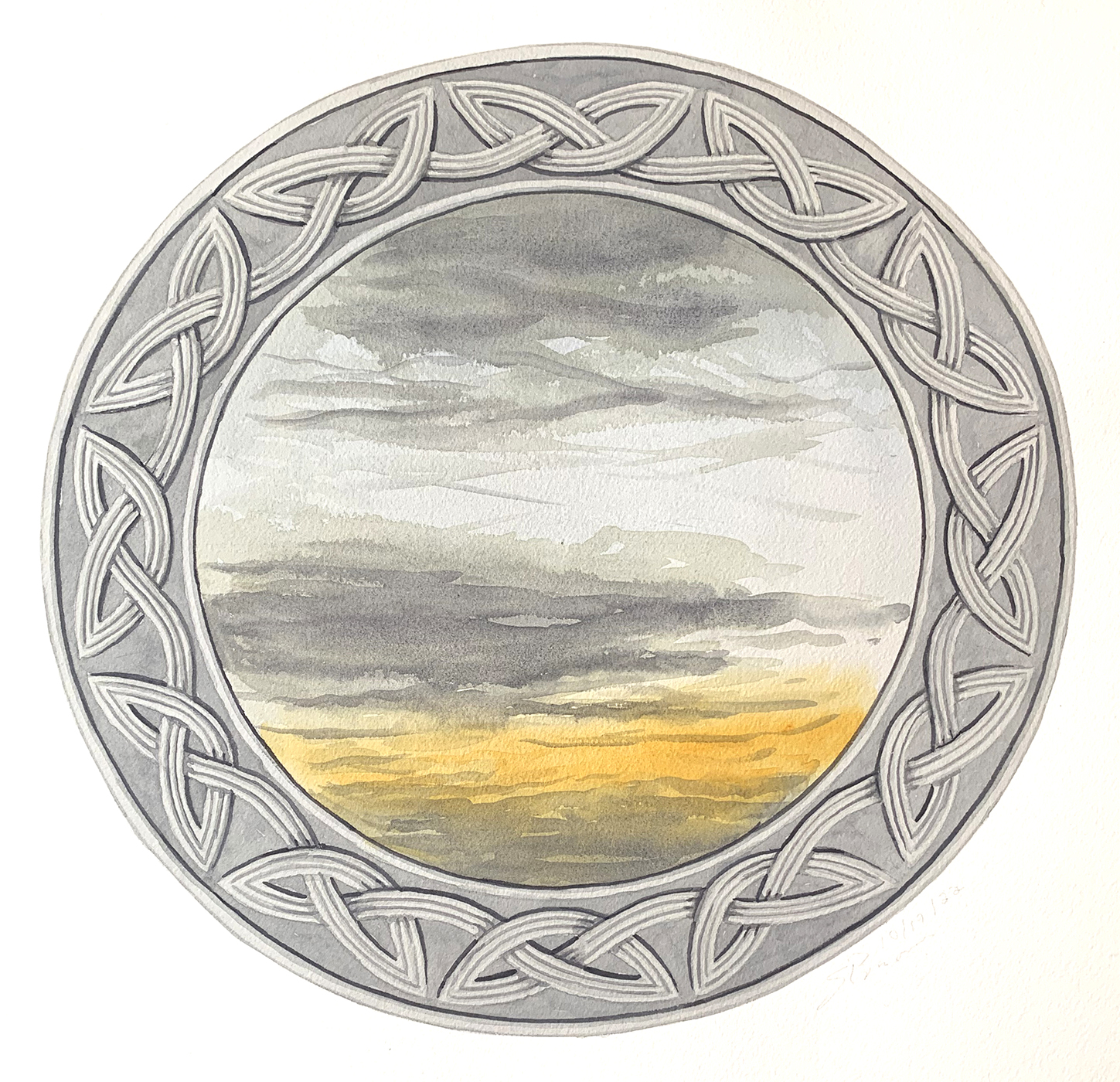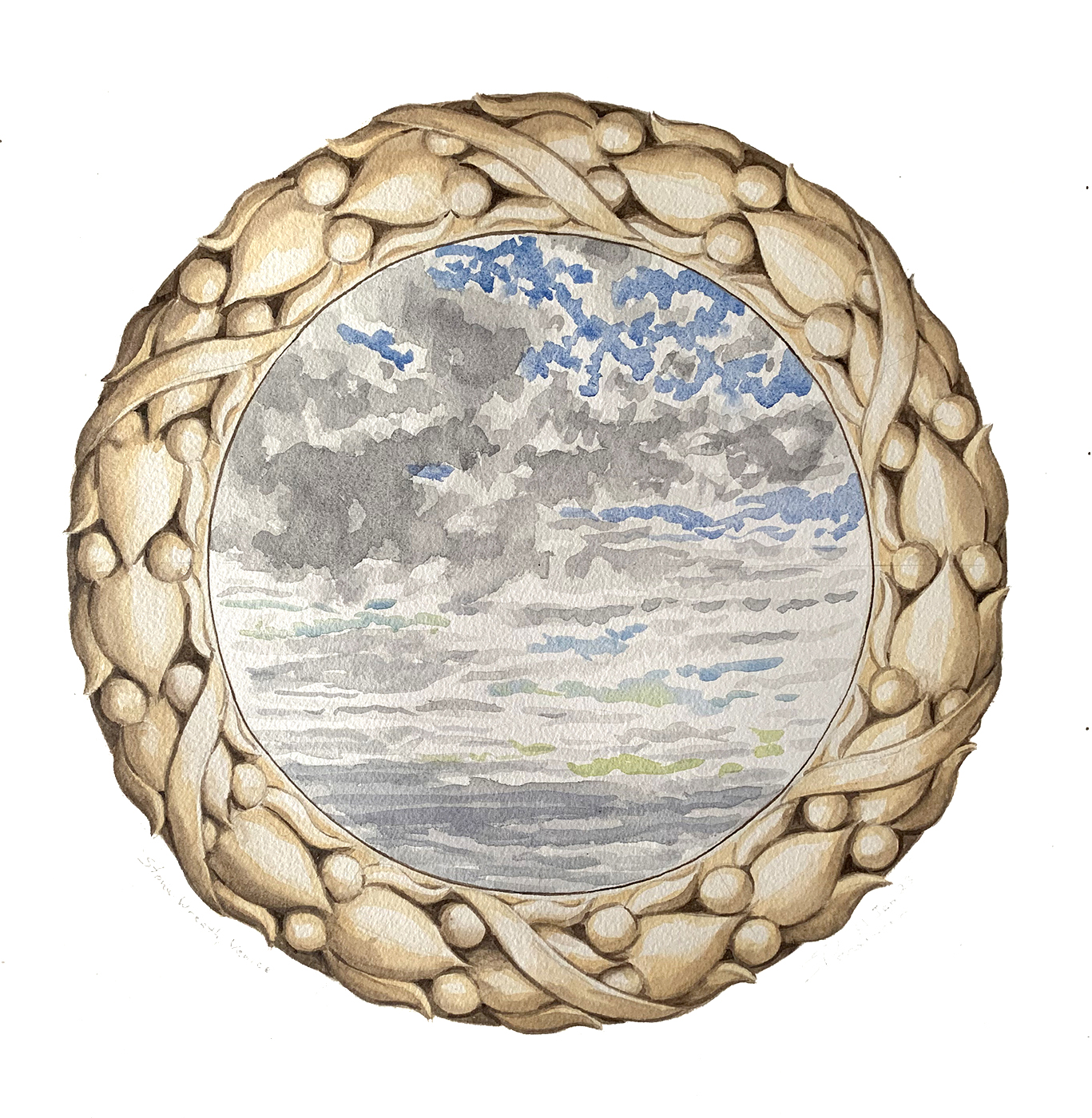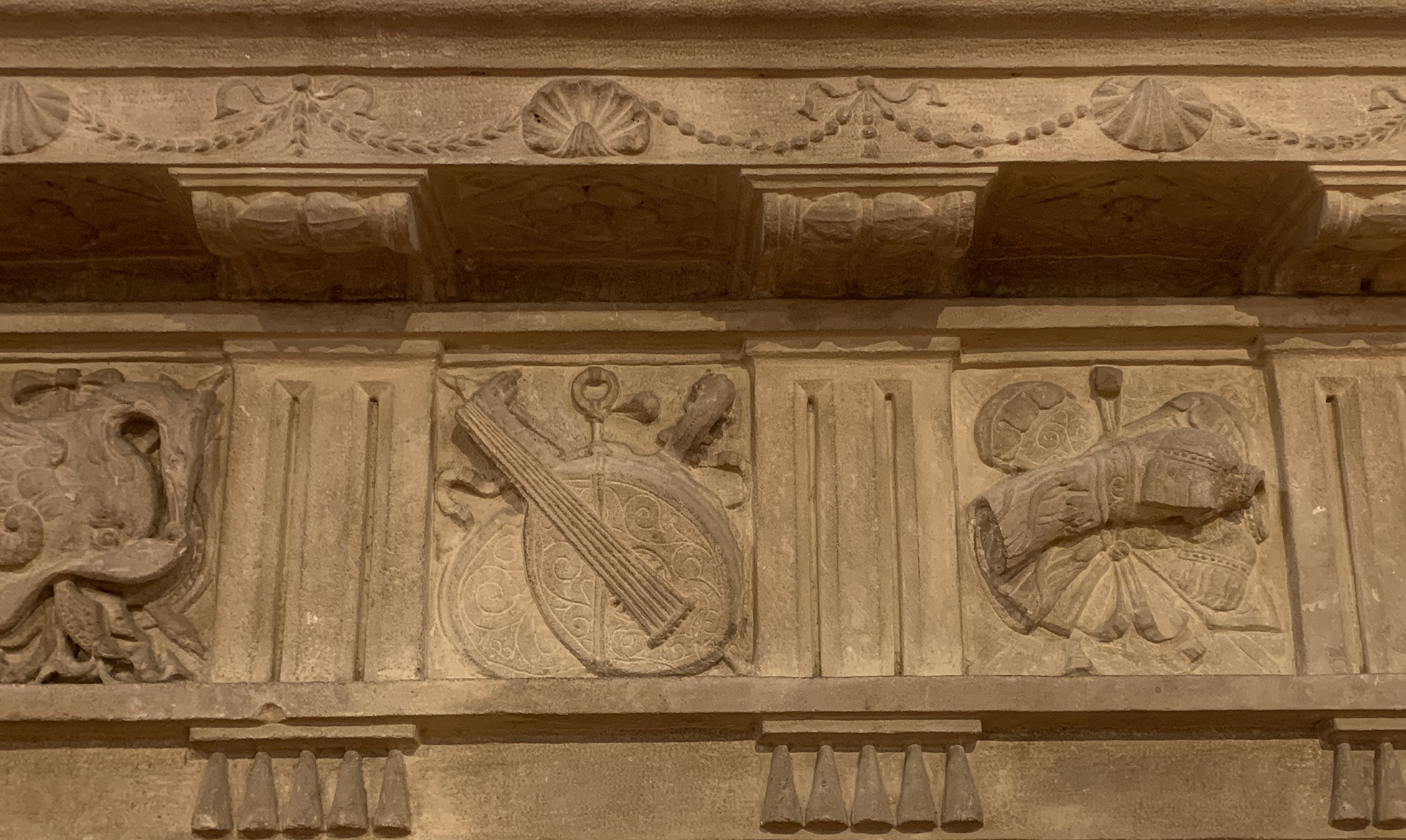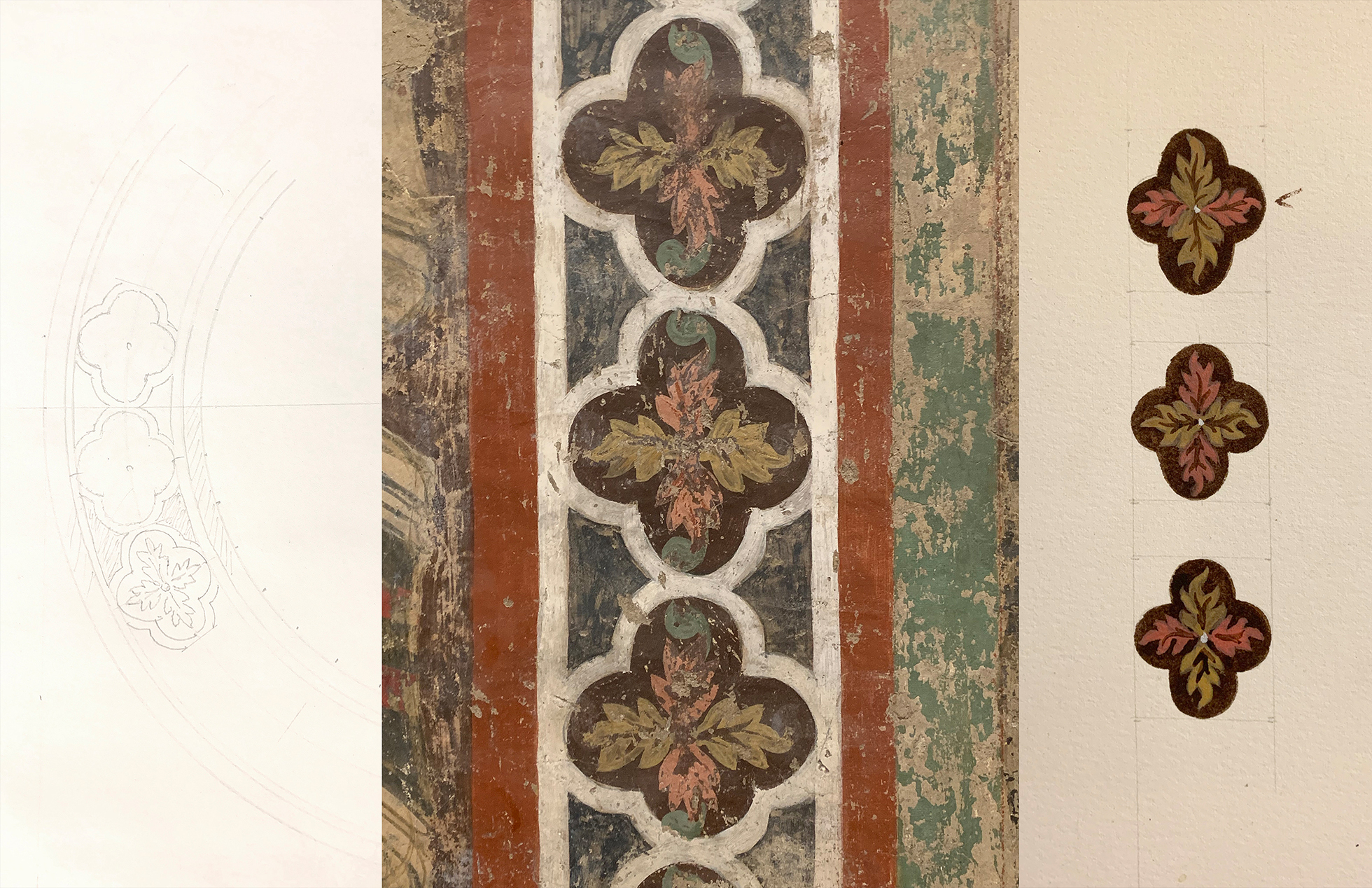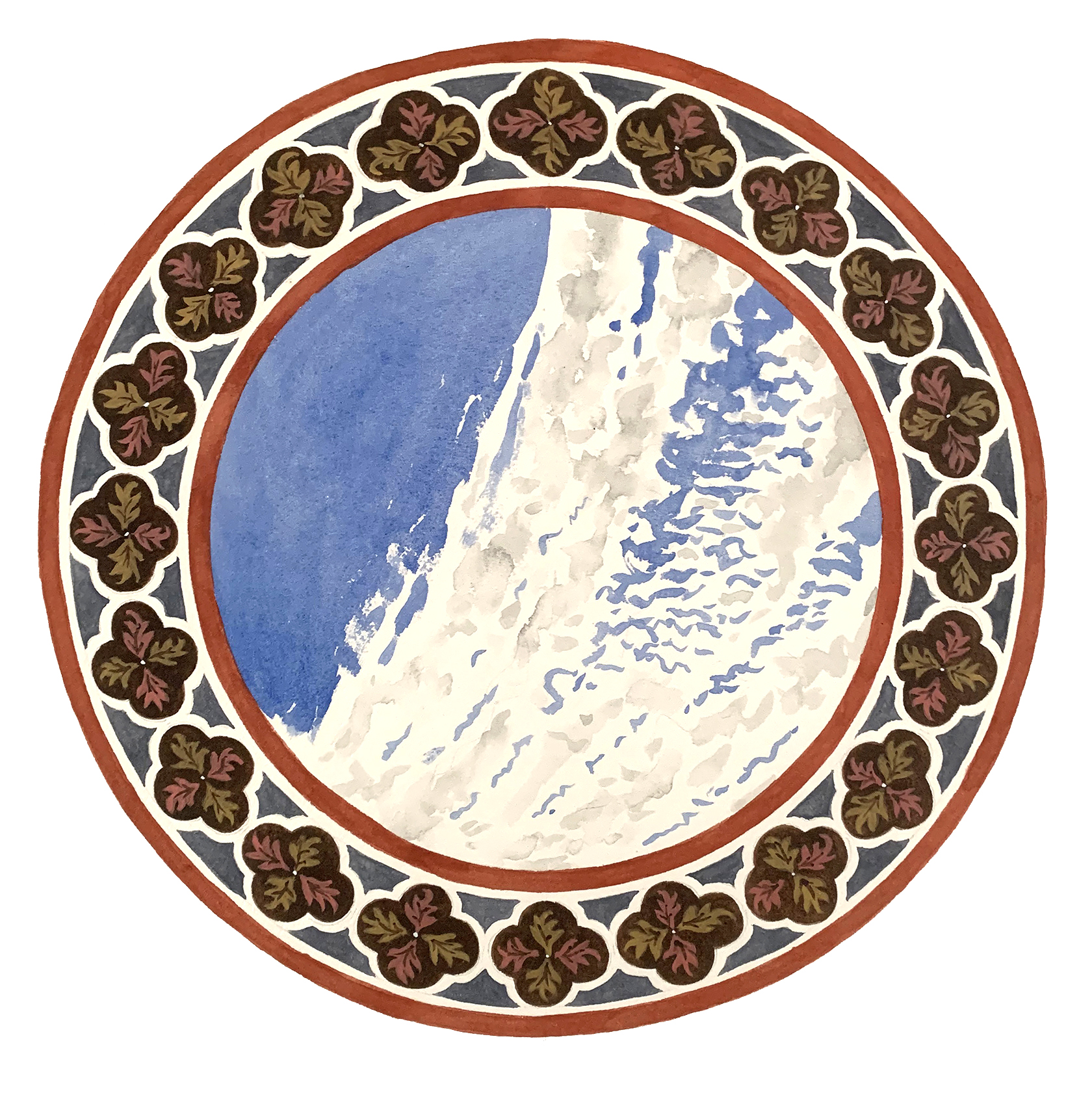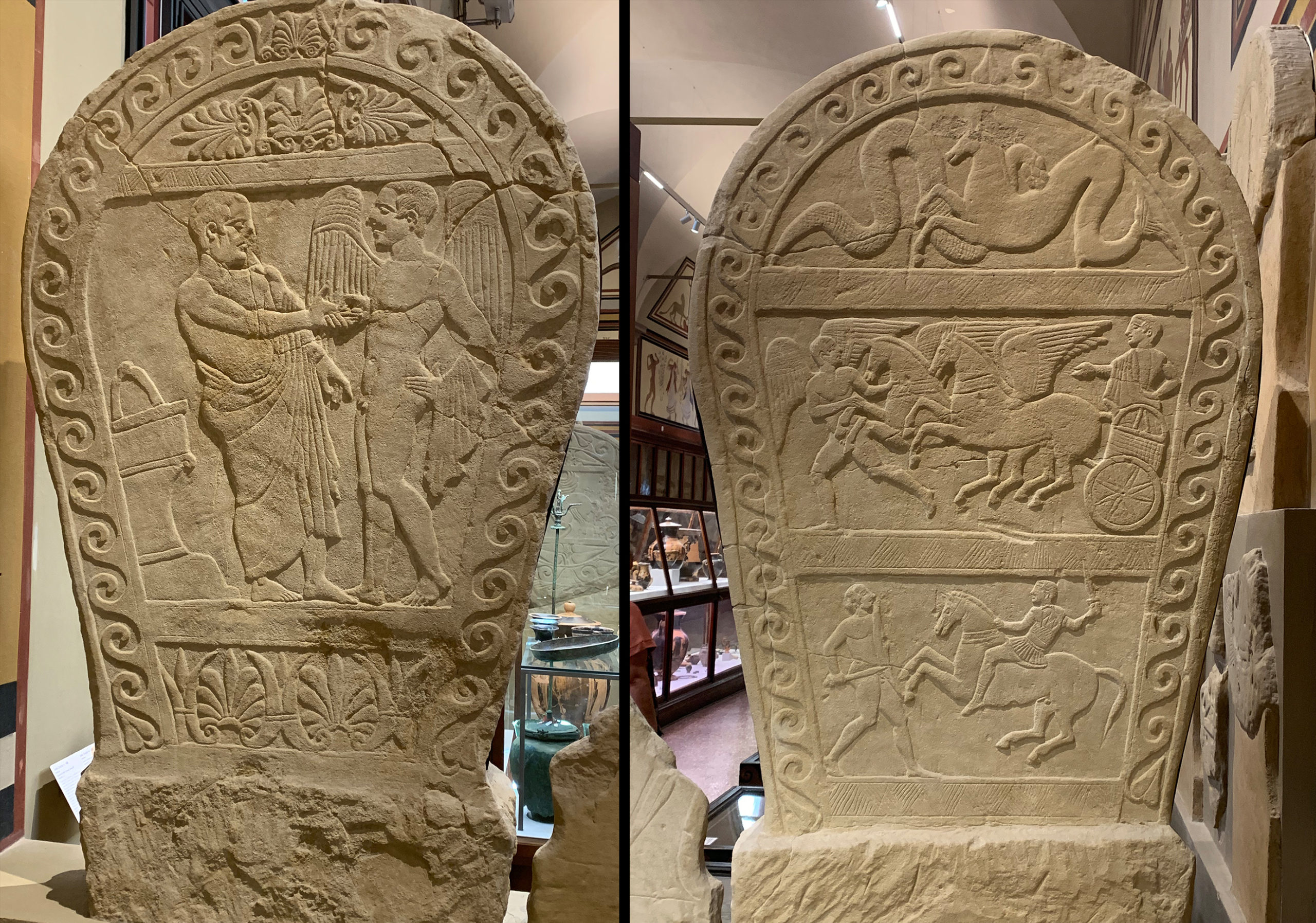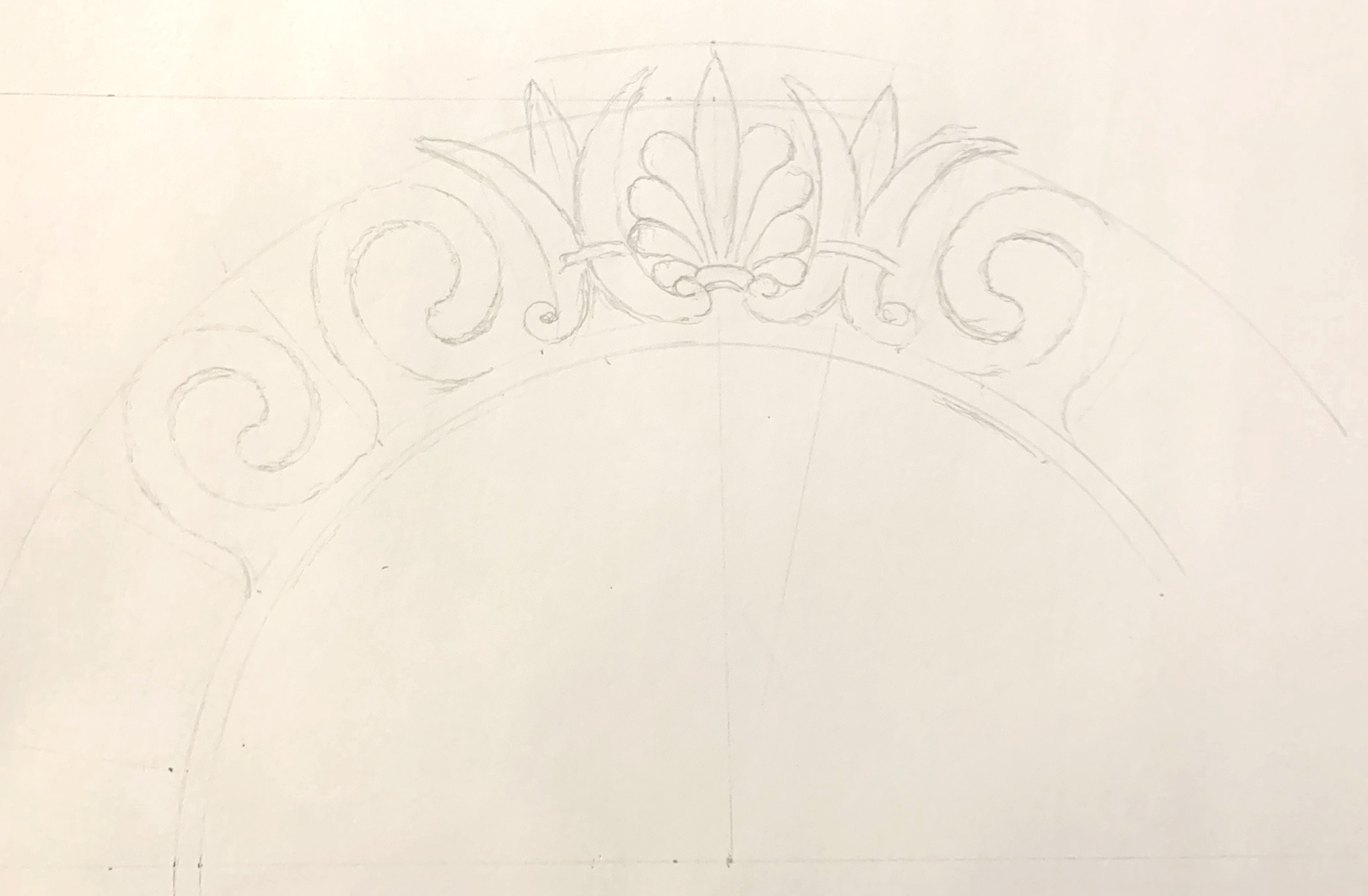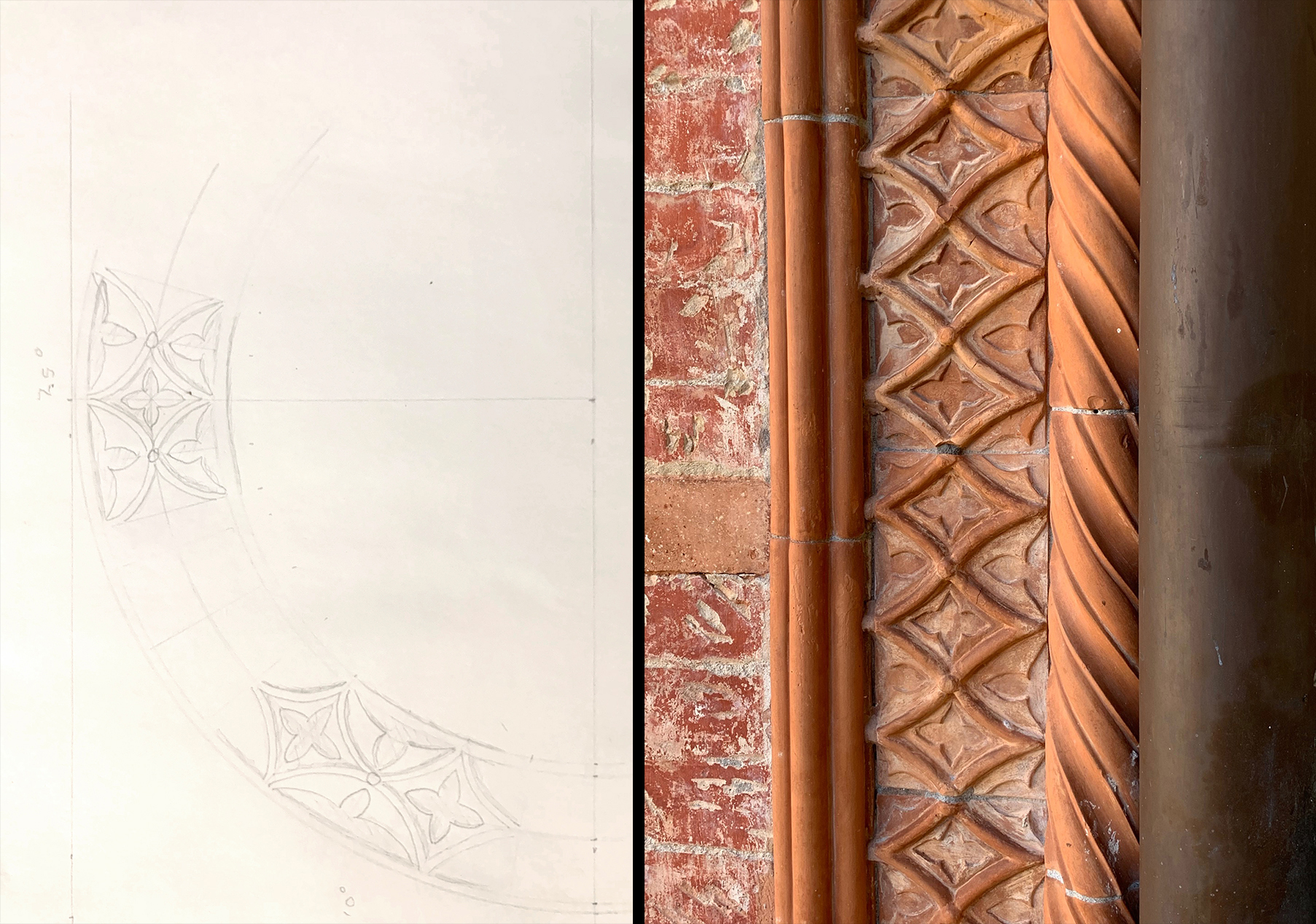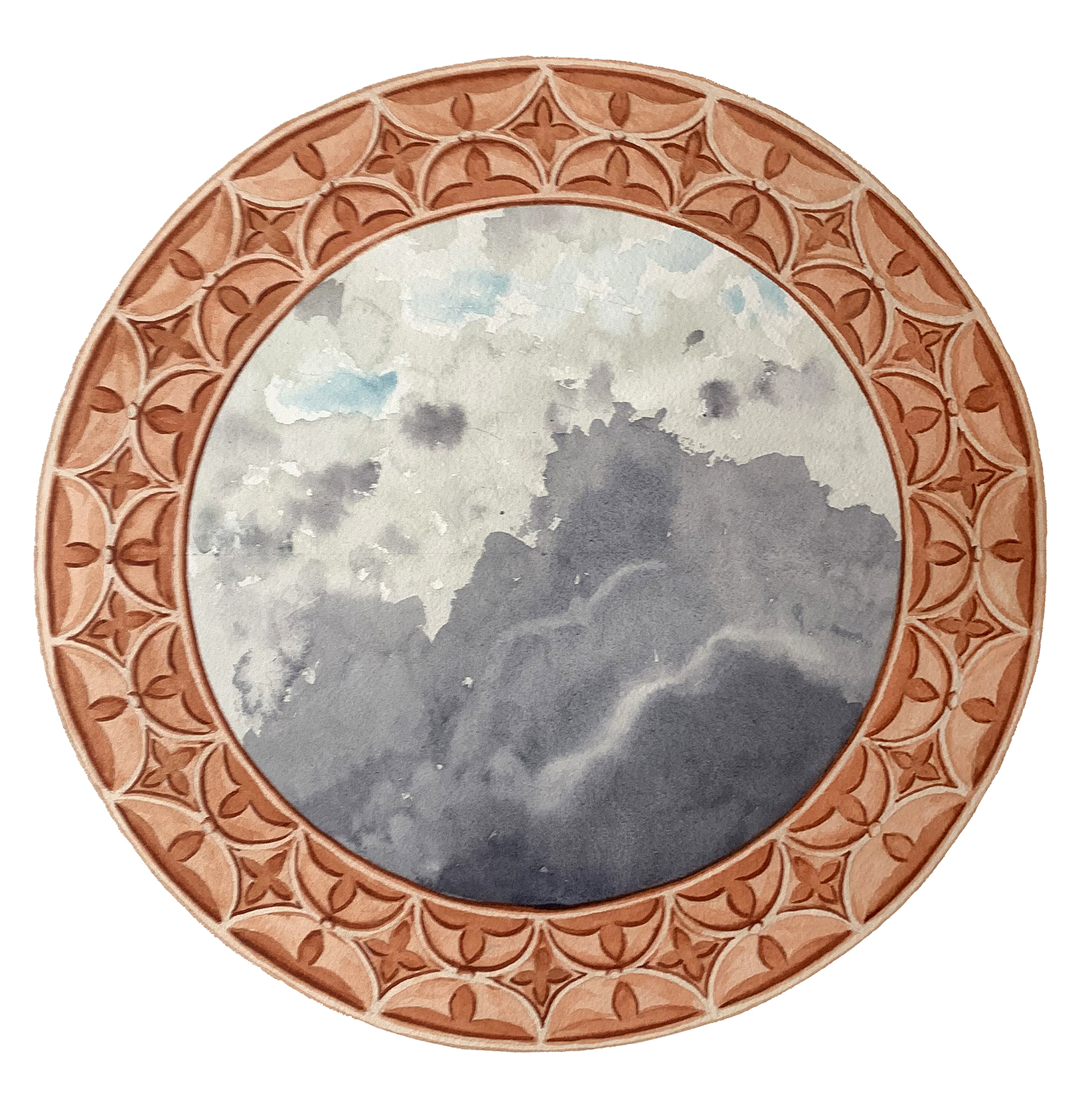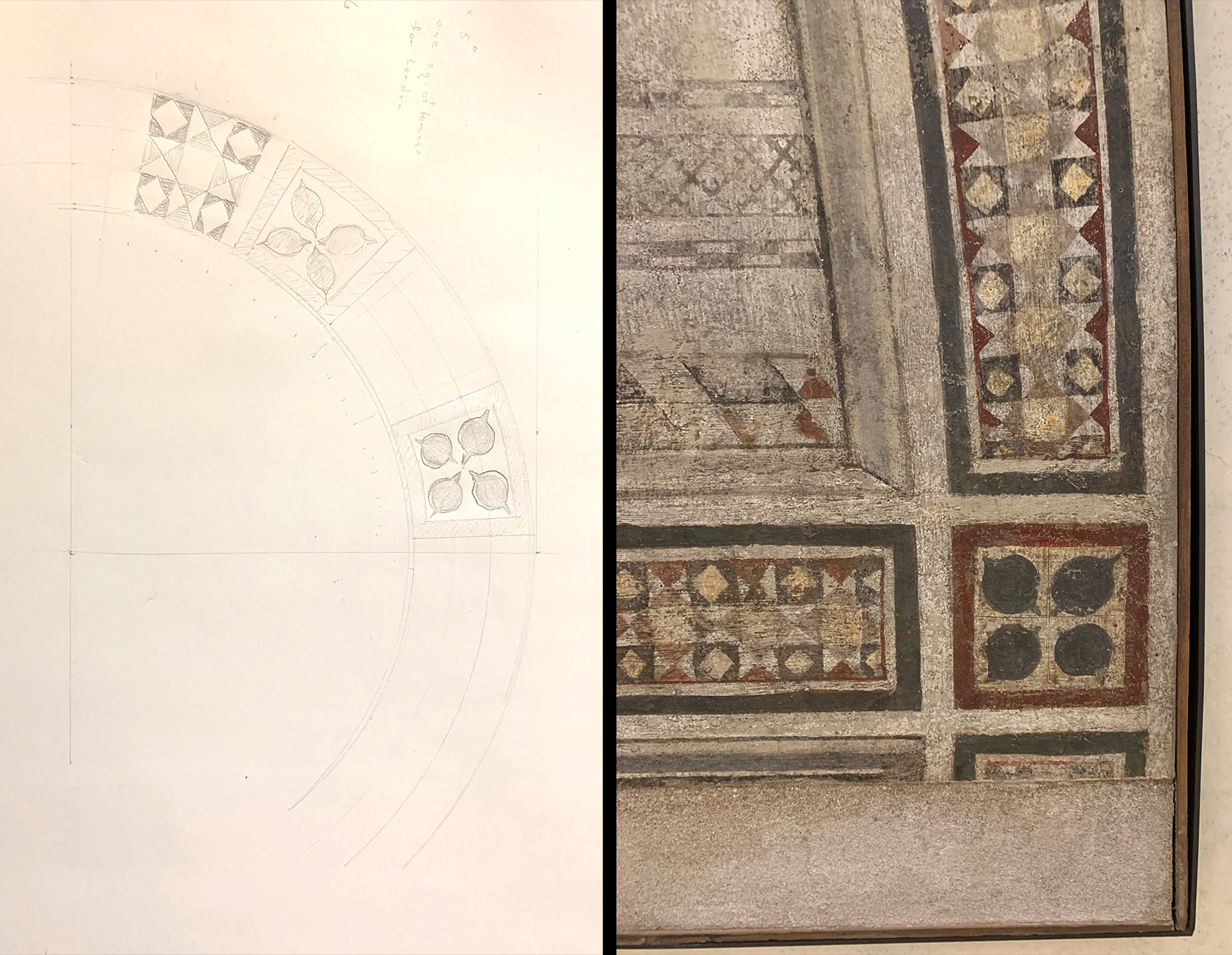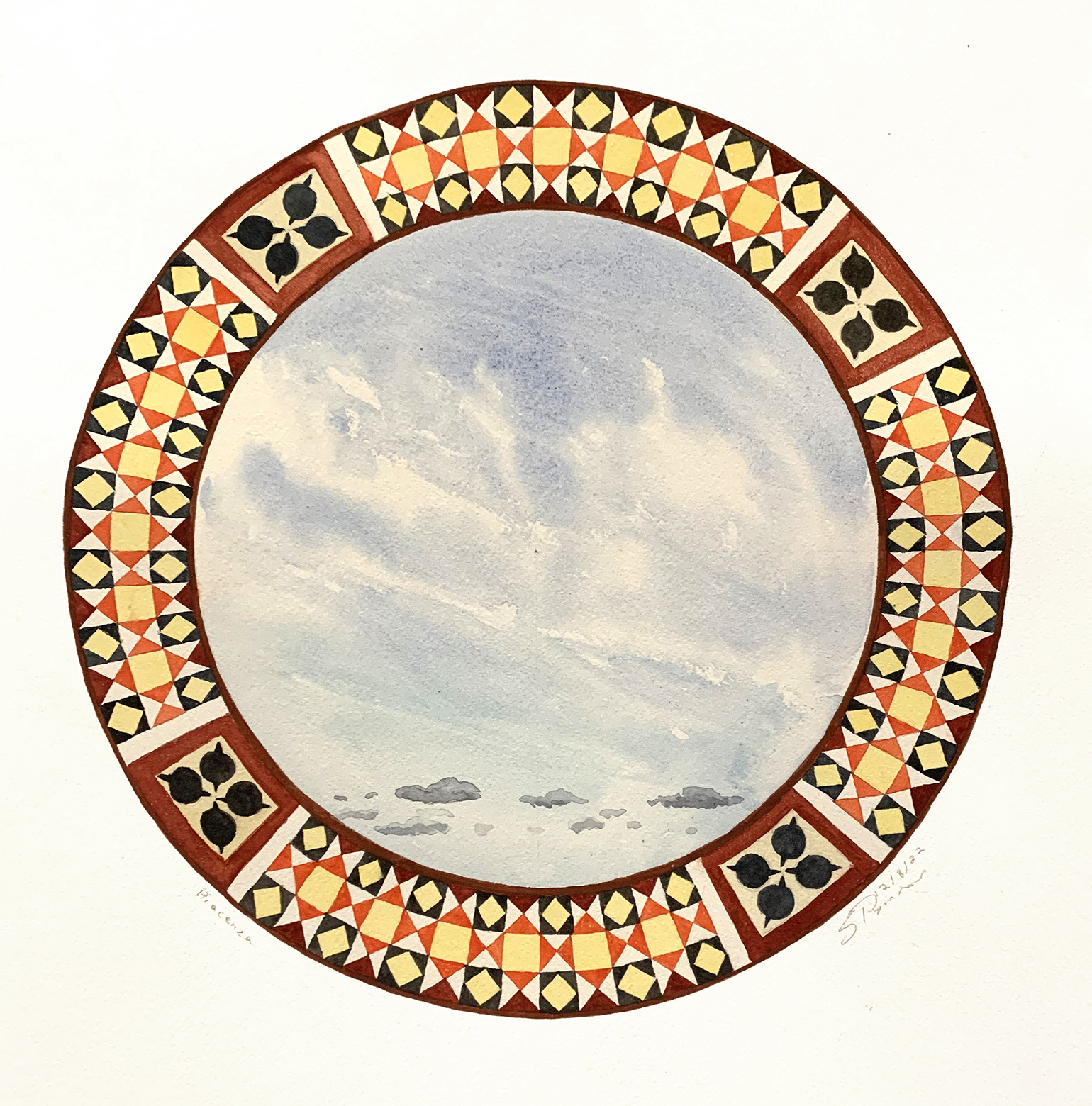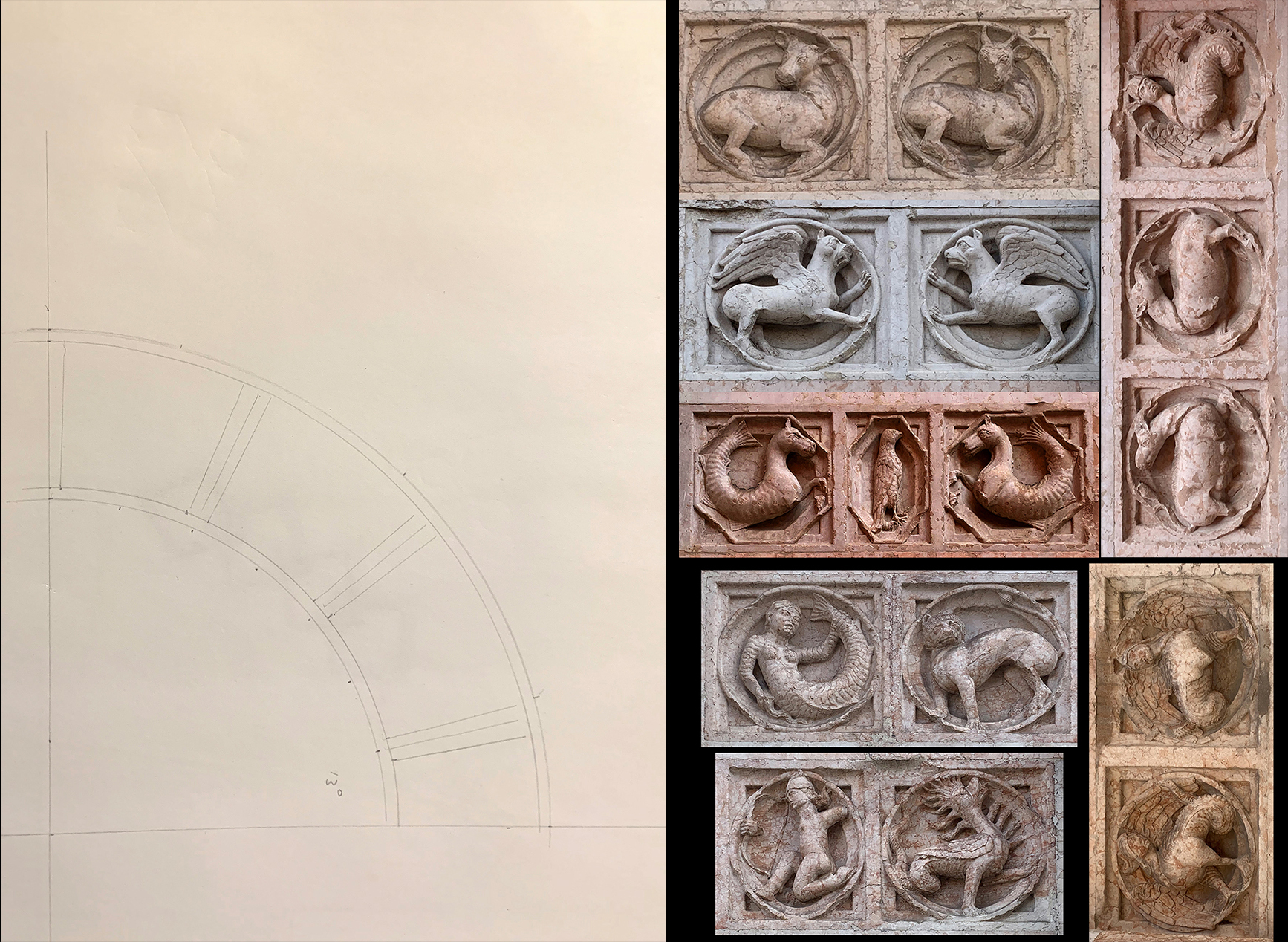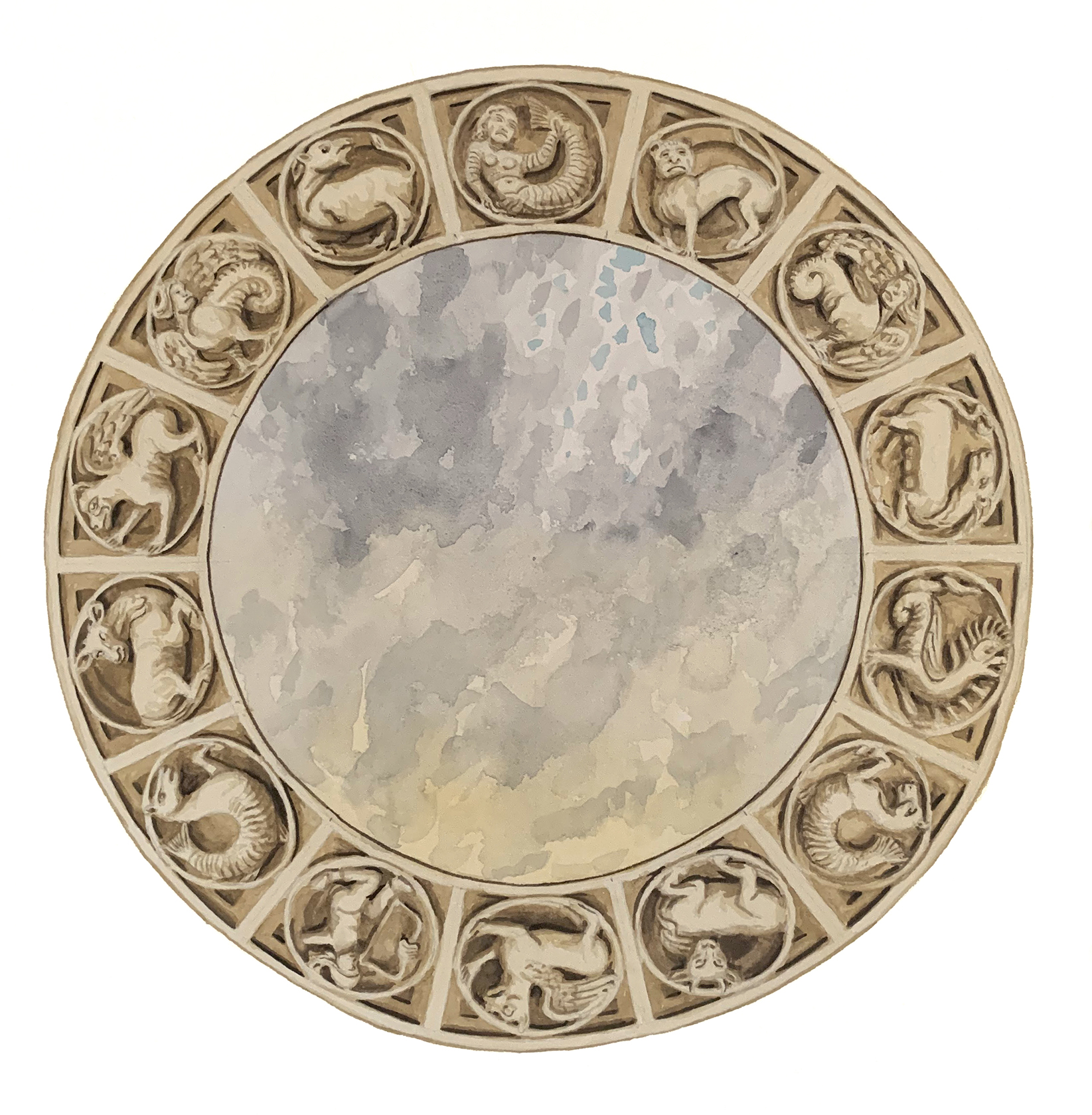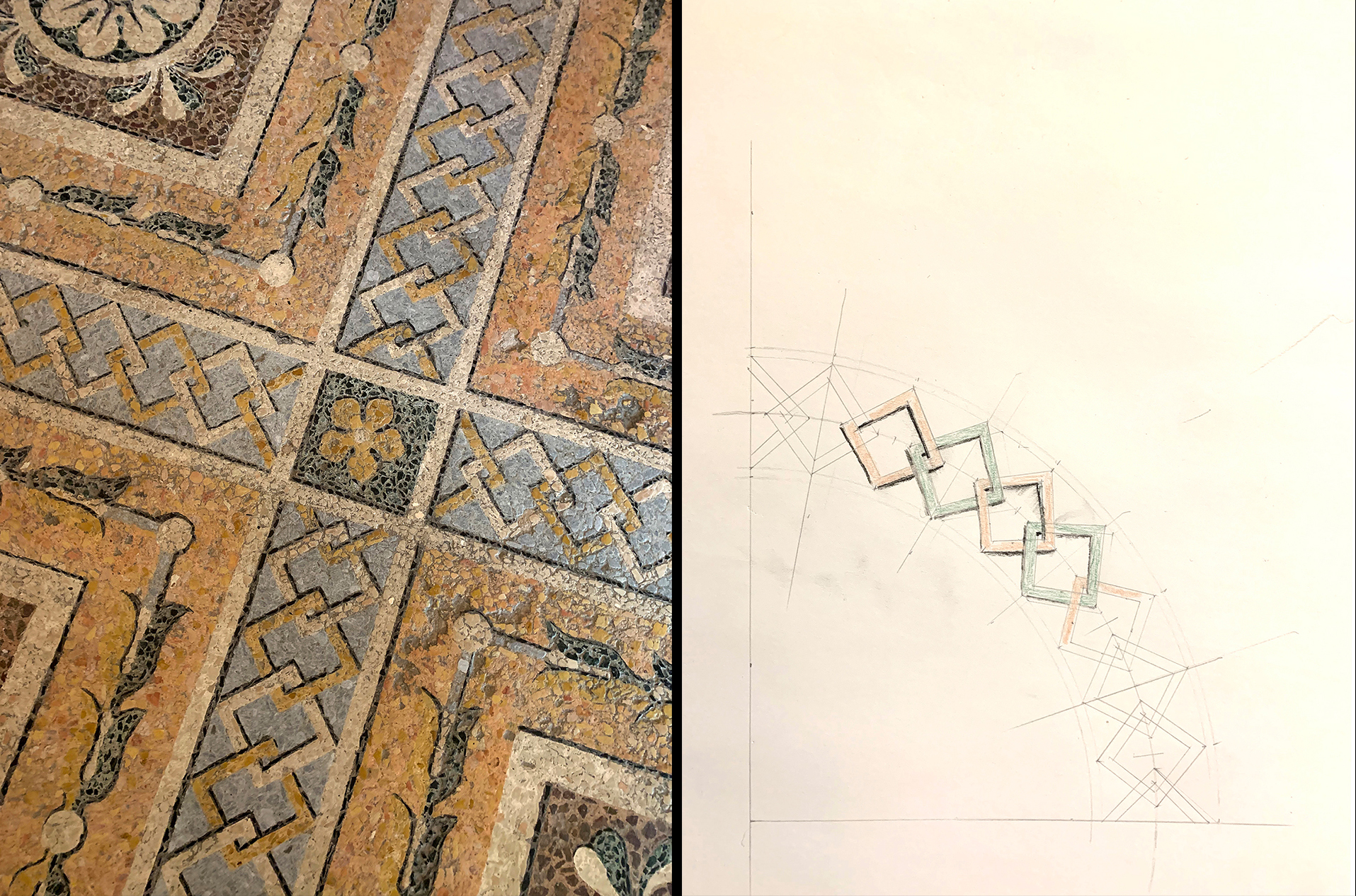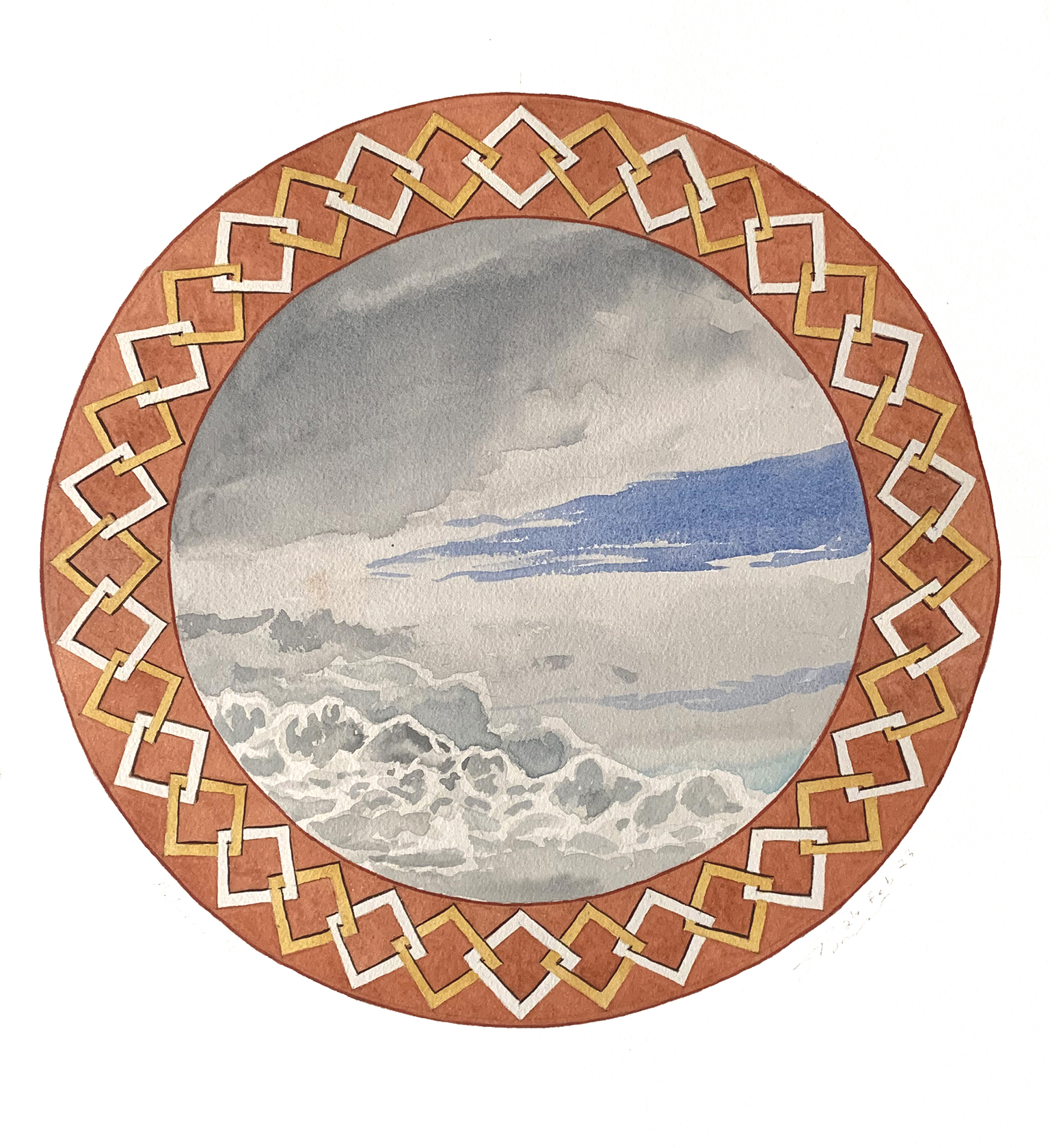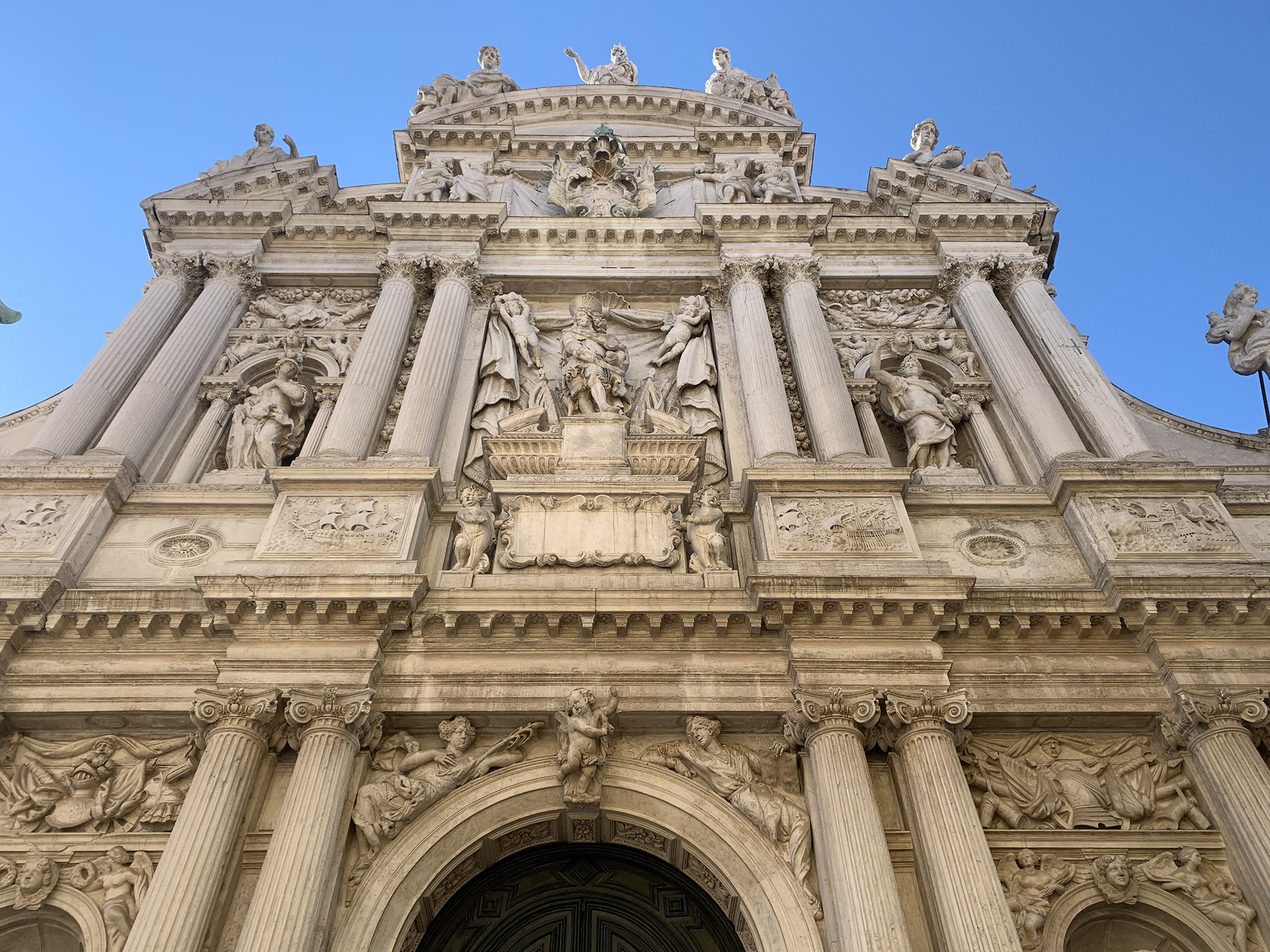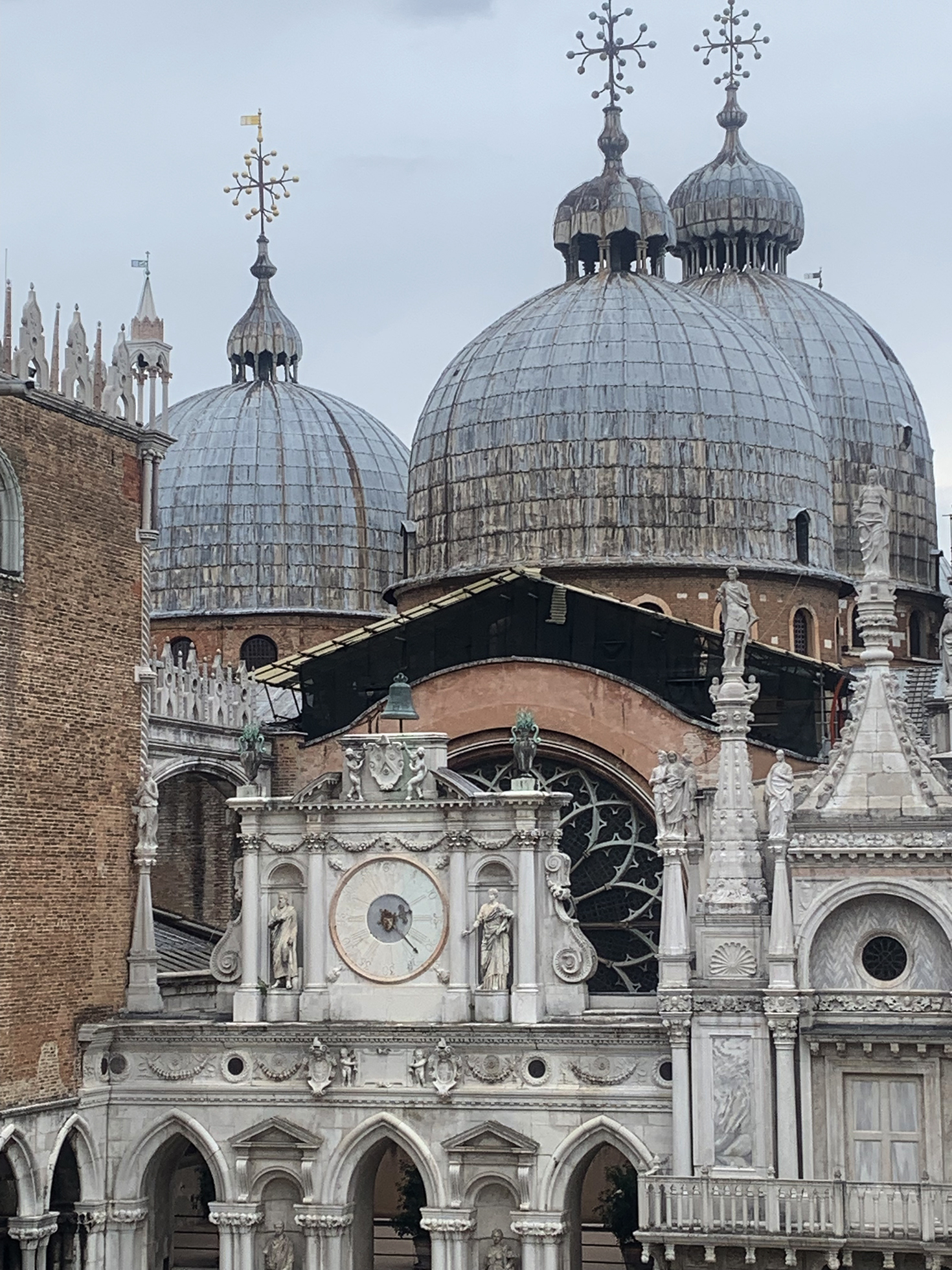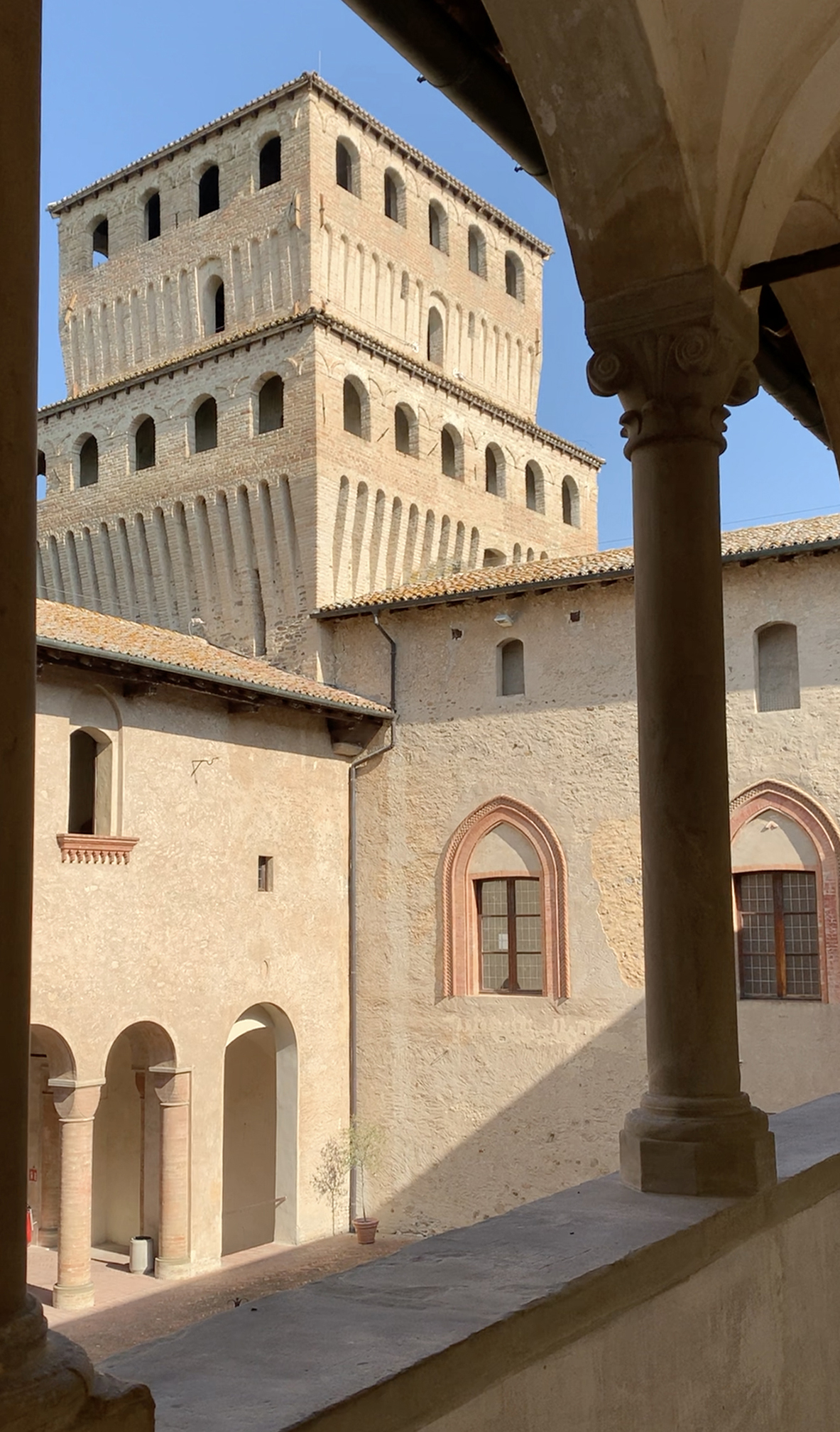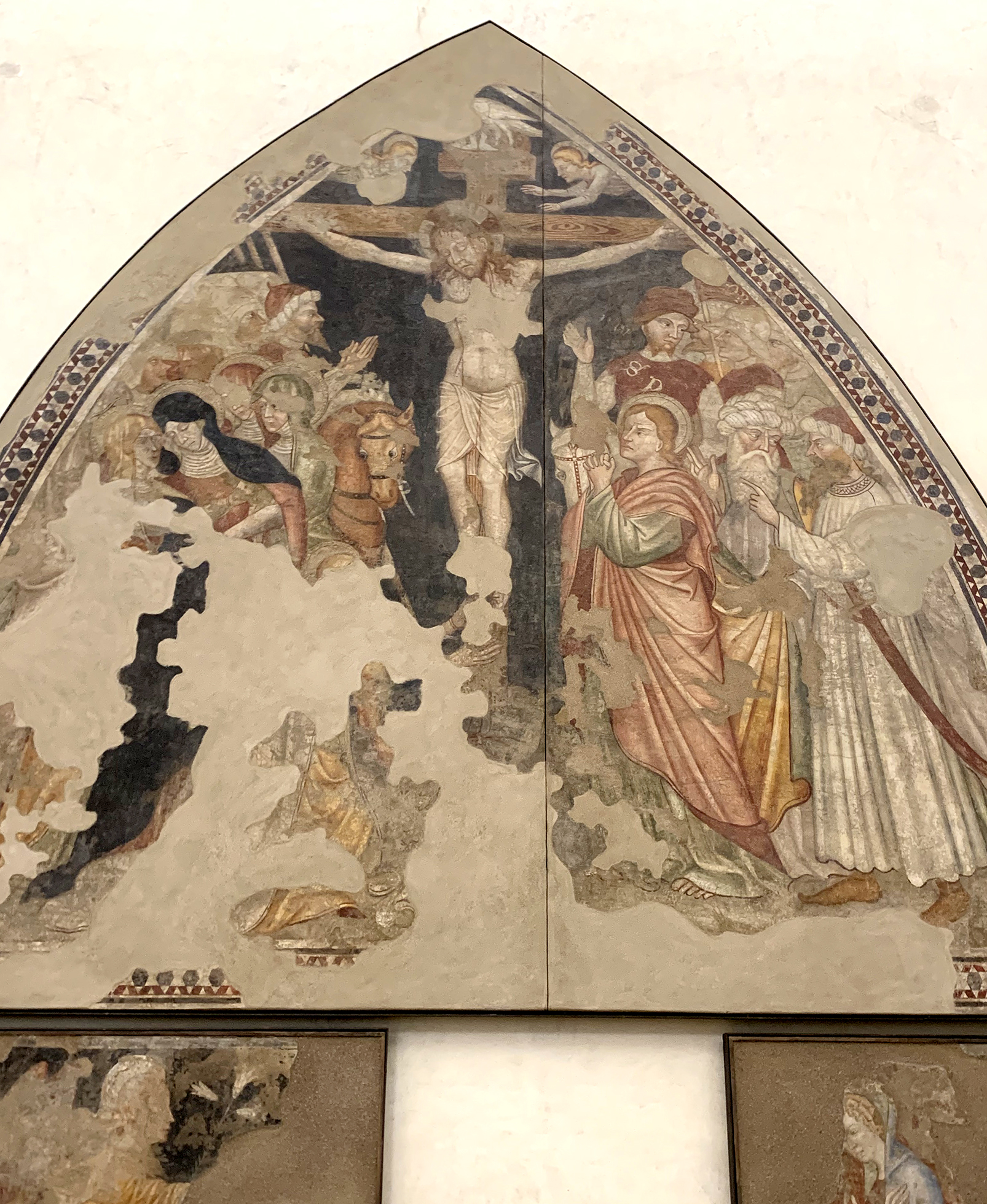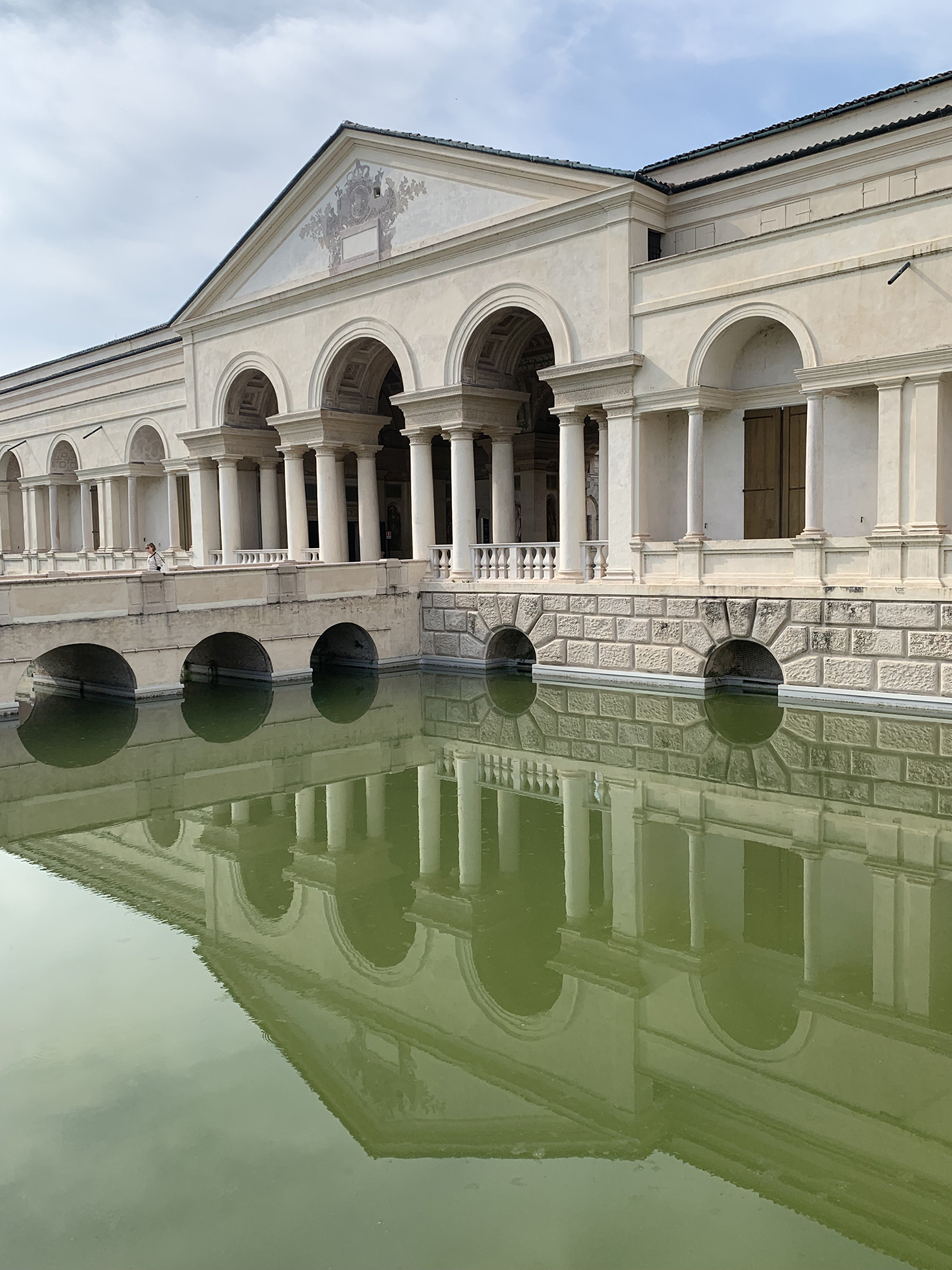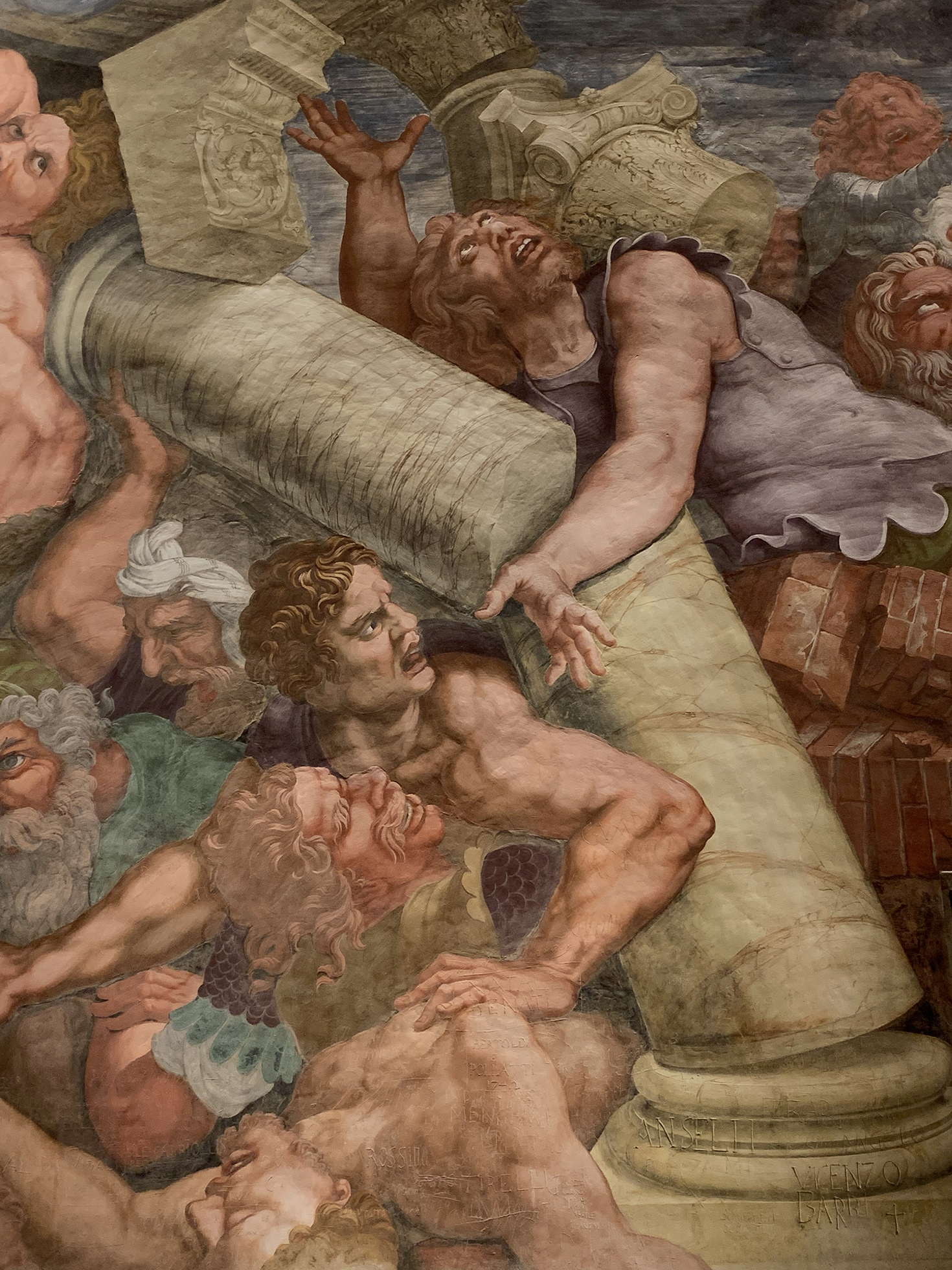Planets Come to Italy
From Skies To Planets
Planets seem to follow me wherever I go. Last fall they followed my to Venice, Bologna and Parma in northern Italy, which is fitting because Planets evolved from a group of watercolors made in Italy in 2012, when we stayed in the hills near Lucca. Those paintings were rectangular, not round as the word “planets” suggests. Yet it was in Lucca that the idea of combining a sky painted from memory and a border composed of a pattern witnessed during a visit to historic buildings originated. Those 2012 Tuscan paintings began a group of watercolors that I named Framed Skies.
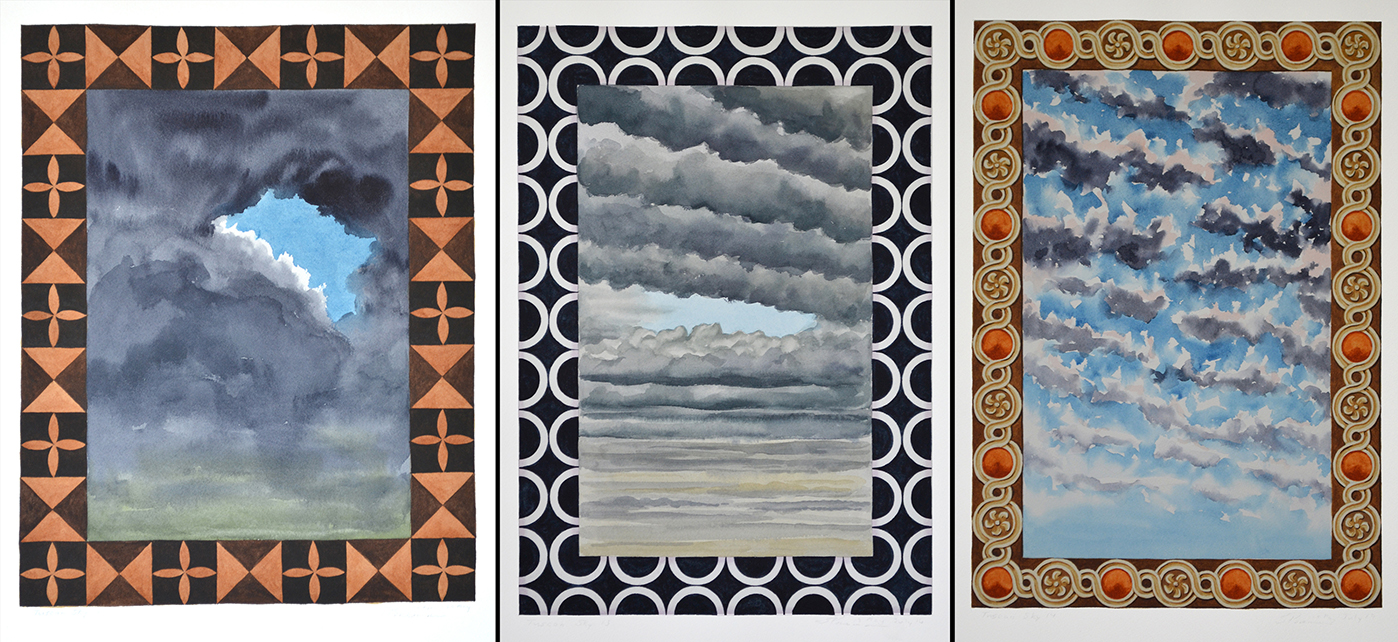 Above are 3 of the 12 Framed Skies I did in Tuscany. They average 14″ x 12″ and began with a sketch in a journal of the pattern–usually from a church pavement. Then upon returning to our apartment, I would work out the geometry so that I could fit the pattern around the corners. Once that was accomplished, I could determine the size of the border and consequently the size of the area for the sky. Then I would paint the sky that I observed during the day. The border was left undone. I would paint it back home. And that became the method of production for skies with borders: painting the skies while traveling and the borders back home.
Above are 3 of the 12 Framed Skies I did in Tuscany. They average 14″ x 12″ and began with a sketch in a journal of the pattern–usually from a church pavement. Then upon returning to our apartment, I would work out the geometry so that I could fit the pattern around the corners. Once that was accomplished, I could determine the size of the border and consequently the size of the area for the sky. Then I would paint the sky that I observed during the day. The border was left undone. I would paint it back home. And that became the method of production for skies with borders: painting the skies while traveling and the borders back home.
Actually, this Planets origin story requires me to go back to 2007, when I enjoyed a residency at Rochefort en Terre, Morbihan, France, thanks to The Alfred and Trafford Klots International Program for Artists of the Maryland Institute College of Arts.
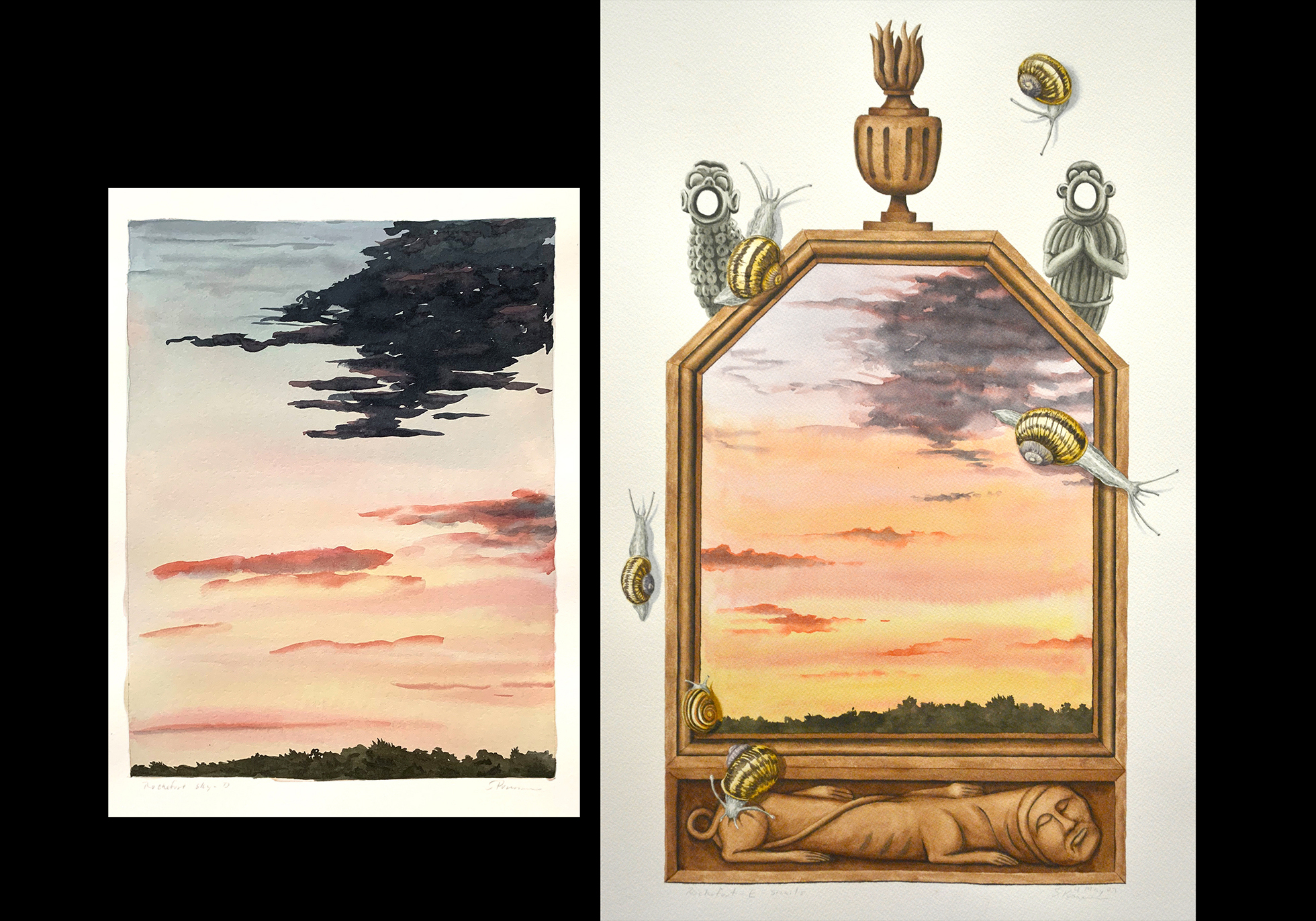
(L) “Rochefort Sky-D”, watercolor, 10 1/2″ x 8″ (R) “Rochefort E-Snails”, watercolor, 4 May 2007, image 18 3/4″ x 12″
The first sky paintings began as studies for paintings of Rochefort-area architectural elements and–in this case–snails from the garden. Never having painting skies before, I felt I needed to practice before I incorporated a sky into a painting. And my first practice sky was a failure. I sat under a tree trying to capture the slow parade of cumulous clouds. It just didn’t work. Then I tried closely observing a sky from various directions until I decided on one particular formation. With that in mind I later painted a sky in my room, starting with what I remembered and finishing with what the painting required.
I so much liked just painting the sky that, once back in Baltimore, I paintings skies for years (mostly 10.5″ x 7″). I had one exhibition of just skies in Bethesda in 2008. One drawer in my flat files is devoted to these paintings.
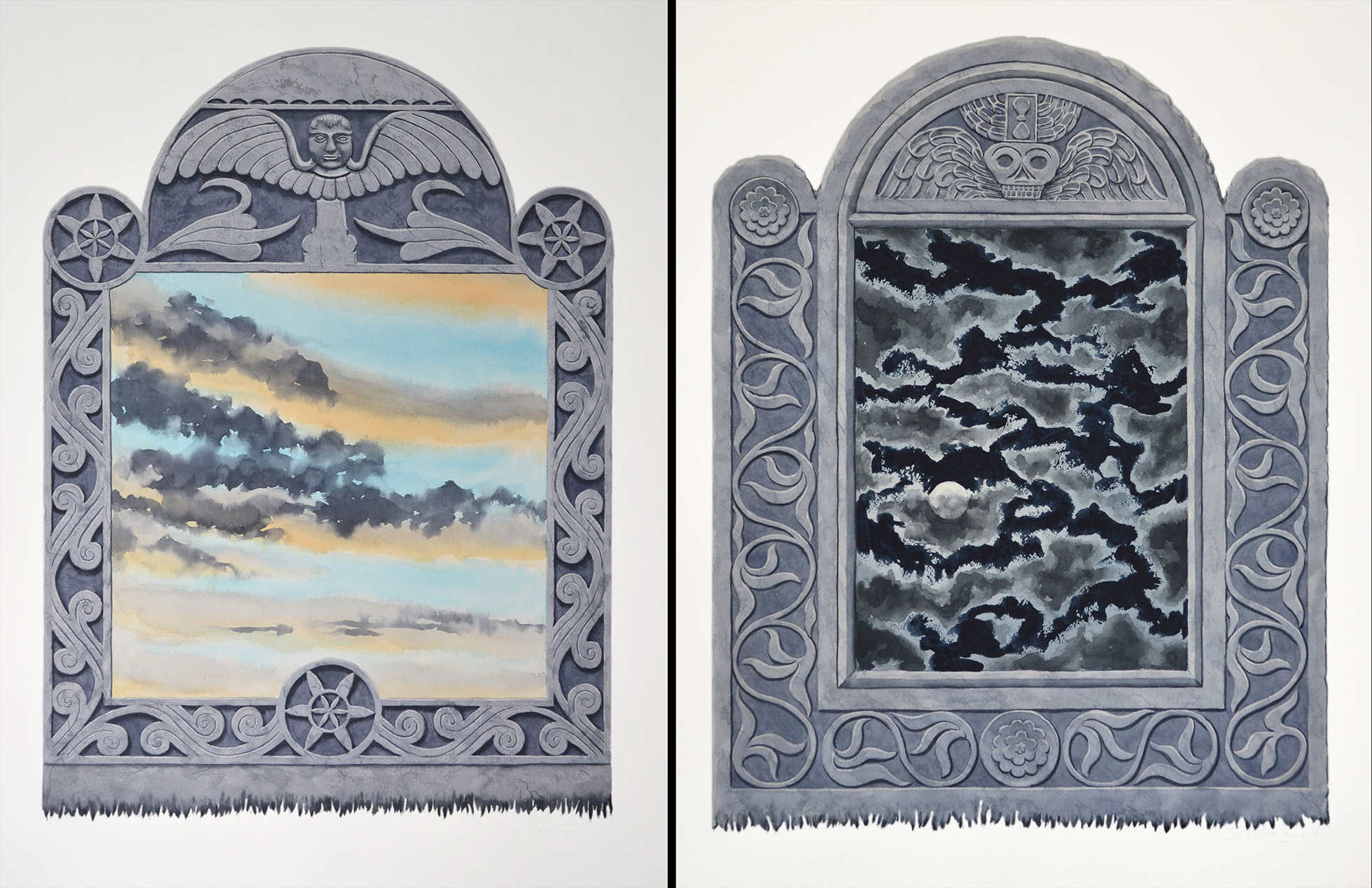
(L) Puritan Sky 4″, watercolor, 18 7/8″ x 14″, 14 July 2014; (R) “Puritan Sky 1″, watercolor, 18″ x 14”, 24 June 2014
The next iteration of “Framed Skies”–thanks to a 2014 stay at an artist friend’s house on Cape Cod–were 18th-century Puritan gravestone-inspired paintings. They certainly look as if that Rochefort painting set a precedent for them, but the 2012 rectangular Italian paintings were their proper antecedent.
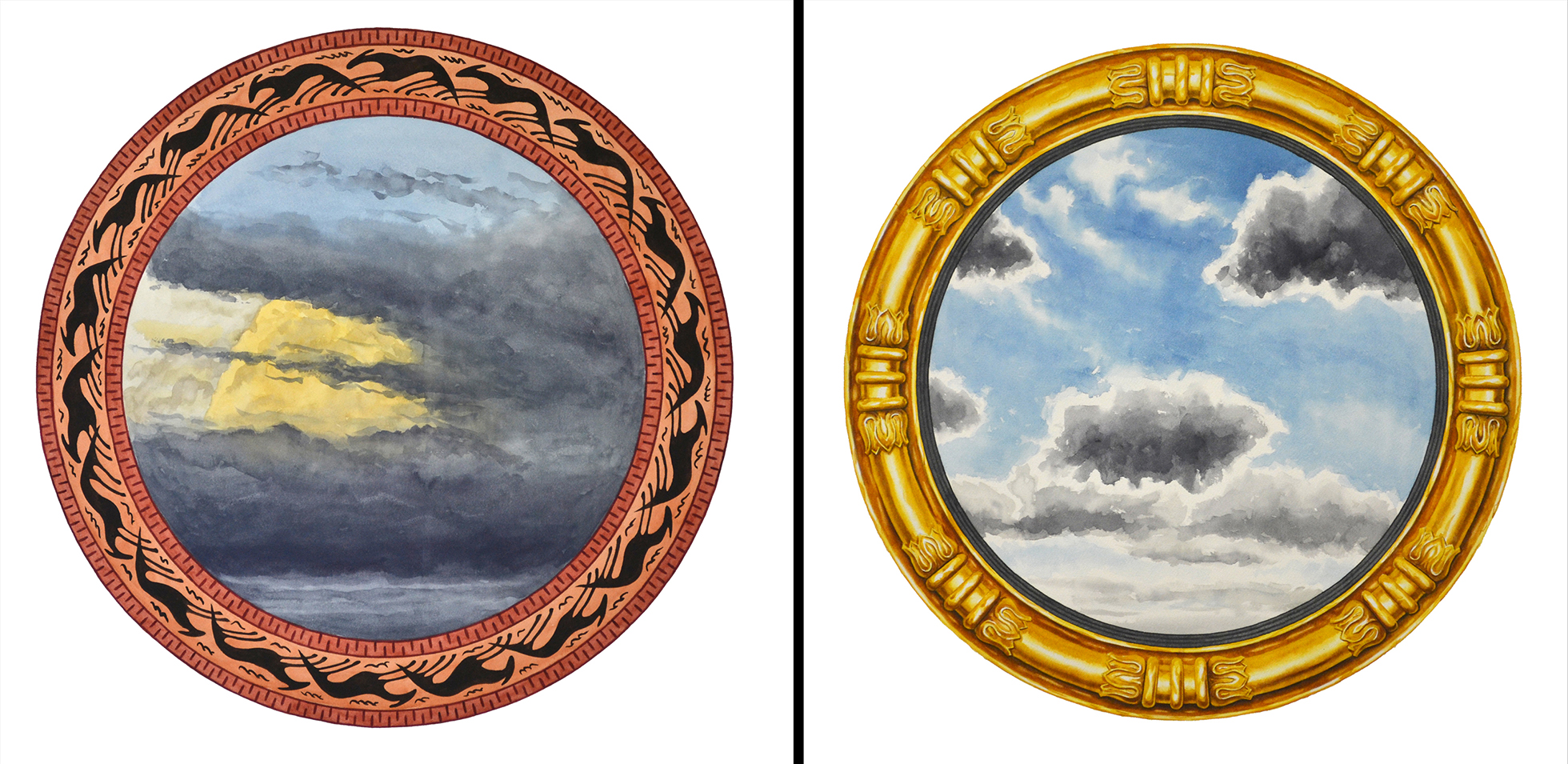
(L) “Planet III”, watercolor, 20″ across, 29 May 2015: (R) “Planet IV”, watercolor, 20″ across, 9 June 2015
Not until 2015 did the first Planets appear. (Essentially Planets are Framed Skies that have gone circular.) Most, like these two, were 20″ across. The one on the left has a border based on a Greek vase at the Walters Art Museum; while the one on the right looked to an American gilt mirror c. 1820. The change in shape was inspired by Italian tondo paintings.
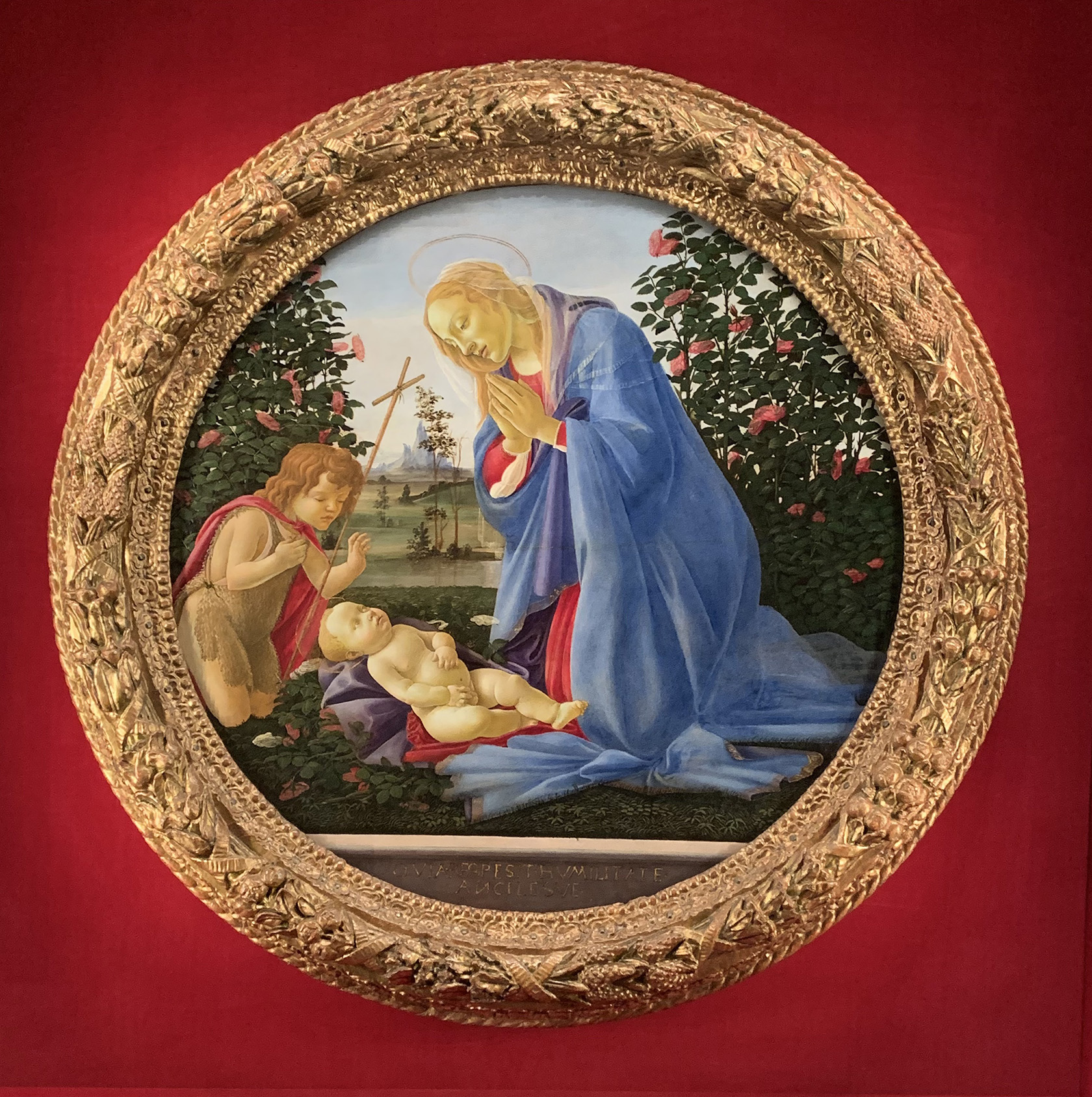
Sandro Botticelli (Florence 1445-1510), “Madonna Adoring the Child with San Giovannino,” egg tempera on wood, Civic Museums of Palazzo Farnese, Piacenza, Italy
This wonderful example of a tondo painting I didn’t see until last fall’s visit to Piacenza, but paintings like it were the inspiration for choosing to make future sky paintings round. The nice thing about borders that run in a circle is that, unlike rectangular paintings, I didn’t have to focus on making the pattern work at the corners. All I had to do was divide the repetitions evenly over 360 degree.
In 2016 I spend a month at PECAH (Programme of Exchange in Culture and Art of Himalayas) in Uttarakhand, India. The art residency was in the hills above Ramnagar. On the few days when the haze cleared the Himalayas shimmered like a mirage in the distance. These two are only 12″ across. Each was designed and painted in a day sitting on my bed. In the half-finished hill station (hotel) where we stayed, there were no studios.
Back home from the PECAH residency, I had the leisure and working studio to create these large Planets. Mughal Sky III (L), 22 3/4″ across, was inspired by a sandstone carved screen at the Red Fort in Agra, India. Sky Aipen IV (R) has a border based on the folk art tradition of Aipen painting.
And when I enjoyed a Green Olive Arts residency in Tetouan, Morocco, in 2018, Planets followed me there. Here are two of the four painted there. Both are 16″ across. The one on the left was inspired a Roman bronze candlestick at a Tetuoan museum; while the other was a play on the intricacies of Muslim geometric design.
While at the Virginia Center for the Creative Arts, south of Charlottesville, in the fall of 2021, I painted (L) VCCA Planet A (22″ across) and (R) VCCA Planet B (21 1/2″ across). Both featured a sky and Shenandoah peaks seen from my bedroom window and ironwork from 19th-century fences in nearby Lynchburg.
Planets Return to Italy
Last fall Planets didn’t return to Italy at first. The first planned painting was rectangular. The inspiration was rather a simple marble floor of the rather exuberant Baroque church of Santa Maria del Giglio. First built in the 10th century, it was last rebuilt with an elaborate Baroque facade in the 18th century. (See photo at the end of this post.)
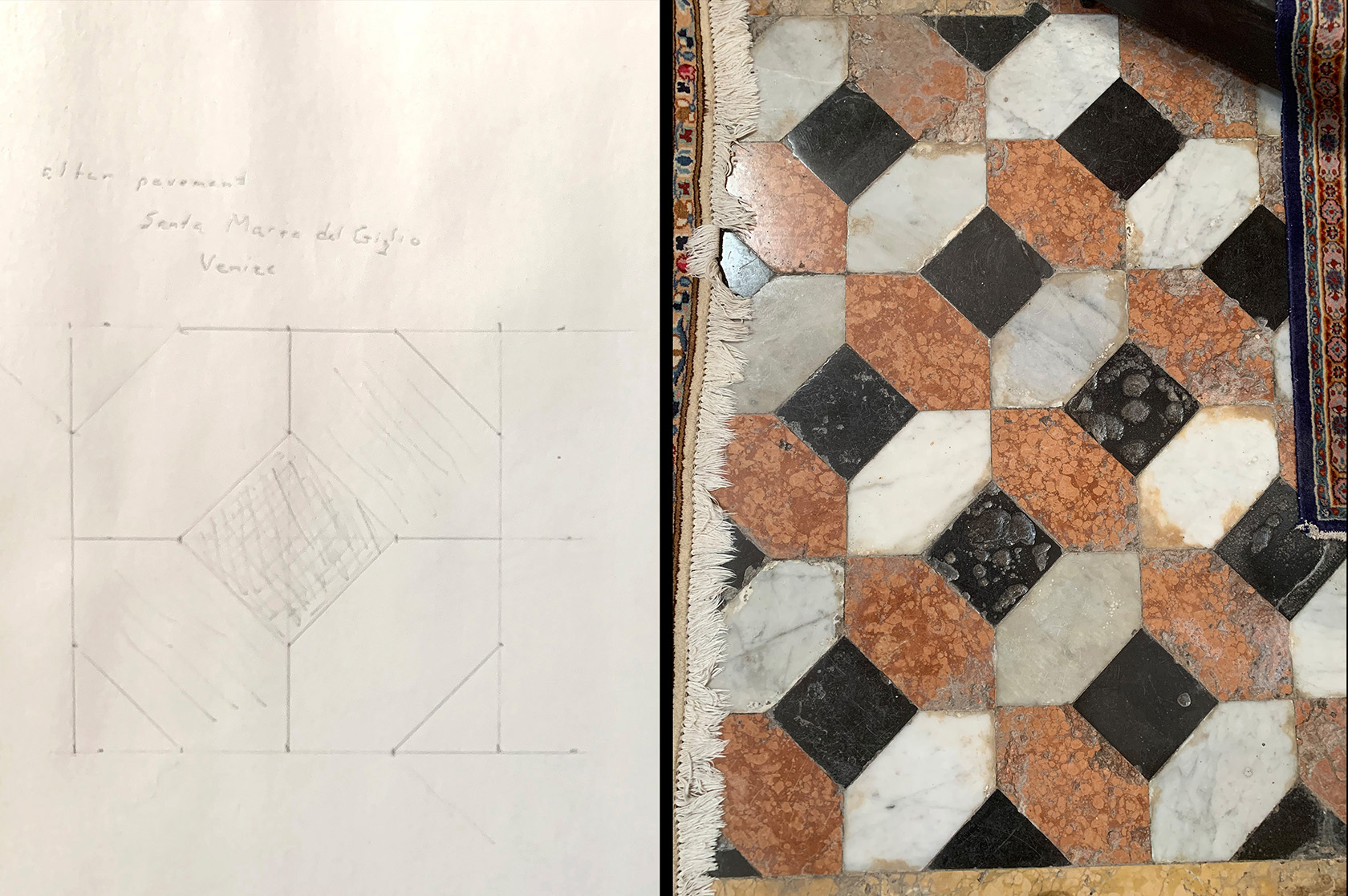
Here is a photo of the floor near the alter and my sketch to reproduce it. Before my essential tremor became more pronounced, I used to draw the pattern in a journal on the spot. Now I need to photograph it and back at the apartment draw it in a sketchbook while looking at the photo on my laptop. As you can see, all I needed to do was draw one unit of the pattern. It was very simple. Just view the unit square as composed of four squares. Then find the midpoint on each side of the squares, and create the diagonals by connecting the midpoints.
The only trouble from transforming this overall pattern into a linear one was the resultant sawtooth-edged rectangle for the sky. It just made flowing a wash of blue watercolor more difficult. Consequently, I abandoned further rectangles. It would be Planets from then on.
On a day’s excursion to the islands north of Venice, the mostly abandoned island of Torcello was the most fascinating. I guess I’m a pushover for relics of Byzantium, and Torcello’s 7th-century Cathedral of Santa Maria Assunta was a beautiful example. The fragment shown here was on display in the nearby museum. My sketch illustrates two things: one, I worked out the pattern on a 90º section, and, two, I fitted the pattern, in this case, into 30º segments. My considerations were: how large I wanted the repeat to be and, consequently, how wide would the border be. Once satisfied with both, I drew two concentric circles–12″ across and 8 1/2″ across–on a sheet of watercolor paper from an Arches cold-pressed 14″ x 20″ block. These circles left a border 1 3/4″ wide. Next, I would mark off 30º segments. I was now ready to paint the sky.
Torcello was completes on 19 Oct. 2022, on the fifth day after returning to Baltimore (and three days after gall bladder surgery).
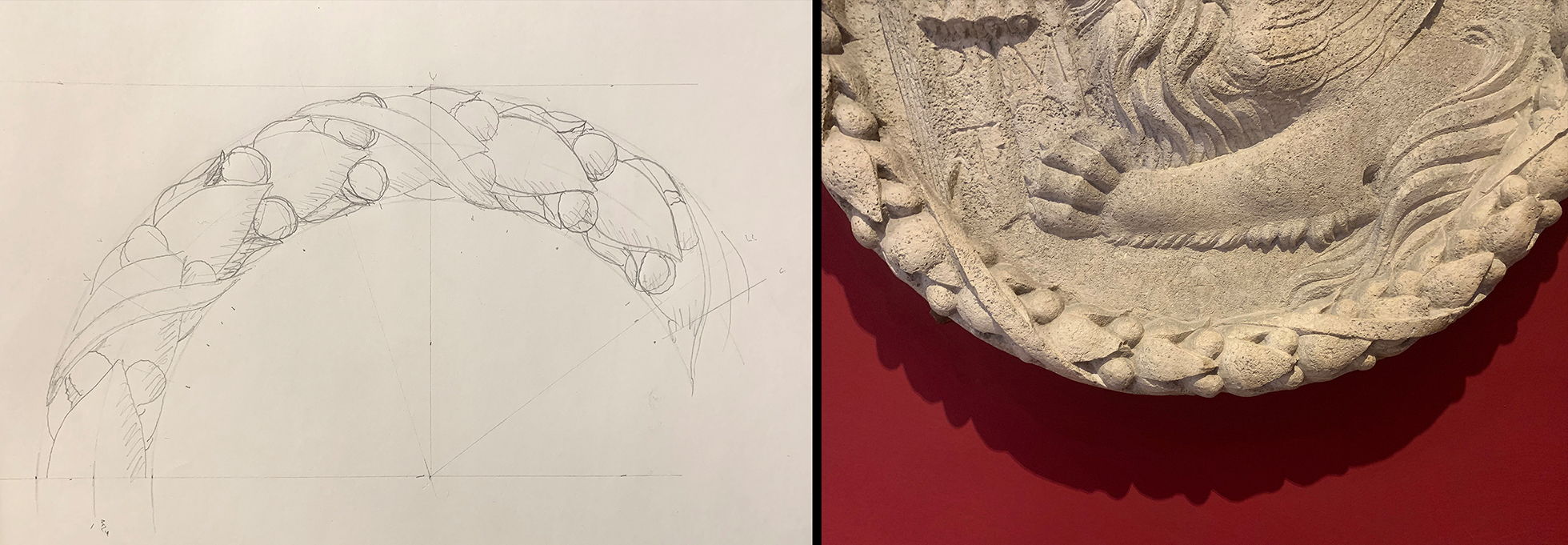
The stone tondo of St. Mark’s lion was on view Museo Correr, which filled buildings on two sides of Piazza San Marco in Venice. I made two sketches of its border. This is the second. The issue was a how to get both of its elements–the ribbon and the flowers–to repeat successfully. I decided that the ribbon would repeat six times–or once each 30º–and the flower would appear in full twice between turns of the ribbon. The resultant border would again be 1 3/4″ wide.
Stone Wreath, Venice was not completed until 31 Jan. 2023.
The next sketch I did was of a carved stone border of shells and swags from a museum in Bologna. I marked it up on a sheet of watercolor paper, but I decided not to do it. I left it undone. When I completed the other Planets from this trip, I then chose a new border for it.
The Pinacoteca Nazionale at the University of Bologna has wonderful installations of detached frescoes. This border (center) is from a fresco removed from the church of Santa Apollonia di Mezzaratta. In a 2-inch-wide border (left) I sized the lobed quatrefoil so it would repeat 20 times, or every 18º of the circle. Because I decided that the best way to paint it would be to first fill the quatrefoil with dark brown paint then overpaint the leaves. It required some practice (right) to get the opacity and brightness of the leaves just right.
Mezzaratta was completed on 31 Oct. 2022.
Bologna’s Museo Civico Archeologico held some wonderful treasures from the area’s Etruscan period including a number of fine sandstone steles. So I worked out a drawing that would be 2 inches wide for the wave pattern and 2.5 inches for the anthemion at top. Eventually I abandoned that pattern, deciding its scale was too large, that it would overwhelm the sky.
This stone border surrounded the door to the Parma Duomo. I found its interlocking hourglass pattern fascinating and, it turned out, too hard to reproduce in my drawing and subsequent painting. The pattern repeated 36 times in the circle or every 10º. The border was only 1.5 inches wide.
Parma Duomo was complete on 2 Dec. 2022.
As we were leaving Bologna, we picked cup a rental car and drove to Parma, which would become of our home base for nine days. This enabled us to make day trips. Our first was to the south and the hilltop castle of Torrechiara. I photographed this terracotta Gothic pattern there. Back in Parma I did two sketches: a wide one where each repeat would be 20º of the circle, and narrow one where the repeat would be 15º. I chose the wider one and I wish I hadn’t. I made the space between the quatrefoils look like a butterfly. The width of the border was to be 1.75 inched.
Torrechiara was completed on 25 Oct. 2022.
On another day we drove west to the small city of Piacenza. There the grand but half-built Palazzo Farnese houses the Musei Civici. That’s where I found the detached fresco from the Chiesa di San Lorenzo. In my sketch I included the corner device of a box of four black lemons. I broke up the circle into 5º units. The eight-pointed stars (see top of the sketch) took up three units, but the actual repetition was only two units. Therefore, a sequence of stars had to have a multiple of two plus one unit. The lemons’ units, including half a unit on each side, took up five units. I decided to use the boxes of lemon four times, but rotated them from the vertical and horizontal axes so as not to be viewed as a cross.
Piacenza was completed on 8 Feb. 2023.
Once I completed the six Planets that paired up a sky with its intended border, I had to decide on borders for the other two skies. The wonderful critters that Benedetto Antelami created as a belt around the exterior of Parma’s early 13th-century Battistero (baptistery) was my first choice. In my sketch I only determined how many units there would be. Fourteen seemed about right to give me the shape that I could work with. The math was kind of skewed. So I rounded the units off to 26º each. I also decided to place all of the various beasts and sole human (an archer) into ovals even though the seahorses were in hexagons. The border would be 2 inches wide.
Parma Zodiac was completed on 20 Feb. 2023.
On our last full day in Italy, we drove north to Mantova (Mantua) to see the Palazzo del Te, which Frederico II Gonzaga built (begun in 1525) as his summer villa. While it’s known for its wonderful frescos by Giulio Romano, I chose the interlocking diamonds from one of the stone mosaic floors for the border of my eighth and last Italian Planet. Each diamond would fill 10º of the border, which would be 1.625 inches wide. As I was choosing colors, I realized that I needed to alter the background color as the light blue gray would conflict with the sky. So I chose a terracotta orange.
Palazzo Te was completed on 26 Feb. 2023.
Availability
All eight of the new Italian Planets are available for $500 plus shipping. Please contact me at: p1m1@comcast.net.
Prices for Framed Skies and other Planets watercolors vary by size. To see those price please go the the links provided below.
LINKS
On my website Framed Skies can be found at: https://www.scottponemone.com/portfolio/framed-skies/
Planets can be found at: https://www.scottponemone.com/portfolio/planets/
Planets that were made in or inspired by my 2016 residency in India can also be found at: https://www.scottponemone.com/portfolio/india-influence/
Travel Photos
Here are additional photos that relate to the eight new Planets watercolors.
The facade of Santa Maria del Giglio, Venice.
The Domes for St. Mark’s Basilica as seen from the courtyard of the Doge’s Palace.
The 15th-century castle of Torrechiara.
Detached 1370-1400 fresco from Chiesa di San Lorenzo installed at Piacenza’s Palazzo Farnese. The fresco is attributed to an assistant of the Master of Saint Catherine.
Inner court of Palazzo del Te in Mantova.
A small section of Julio Romano’s famous fresco in the Sala del Giganti (Salon of the Giants) in Palazzo del Te.
***
Trackback URL: https://www.scottponemone.com/planets-come-to-italy/trackback/

